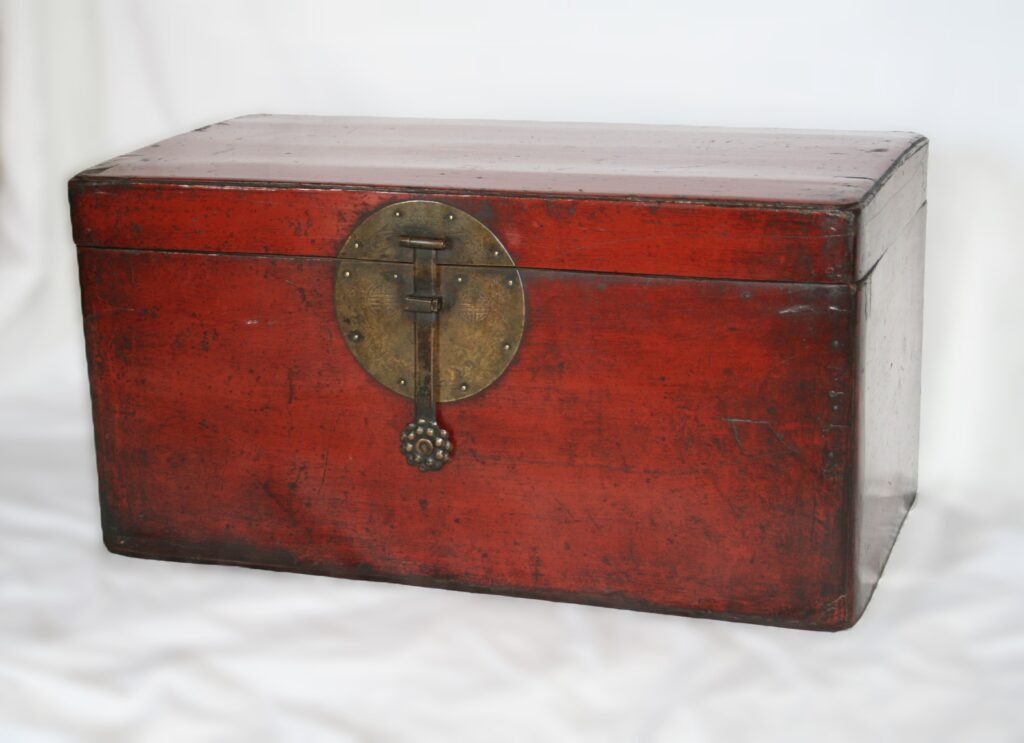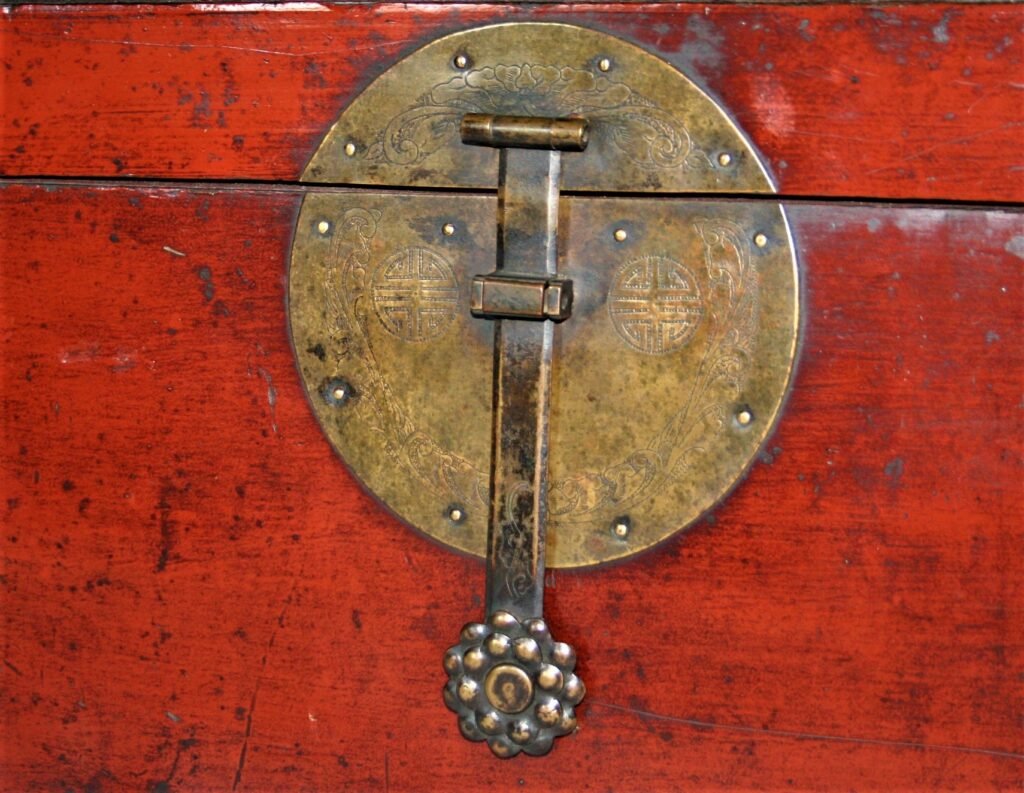COLLECTION “ANTIKASIA”
The acquisition of our first piece of Korean furniture dates back to the mid-80s when we lived in Seoul.
From the outset, we were captivated by the beauty of the architecture and the extensive use of wood, a crucial material in Korean craftsmanship. Their furniture, often rustic and crafted from a variety of woods, possessed a distinct character that set it apart from pieces found in neighboring countries like China or Japan.
Following our departure from Korea in the early 90s, we continued our frequent visits to the country in search of more unique pieces. Over the course of many years, we had the privilege of meeting collectors, dealers, and restorers who contributed to deepening our knowledge on this subject.
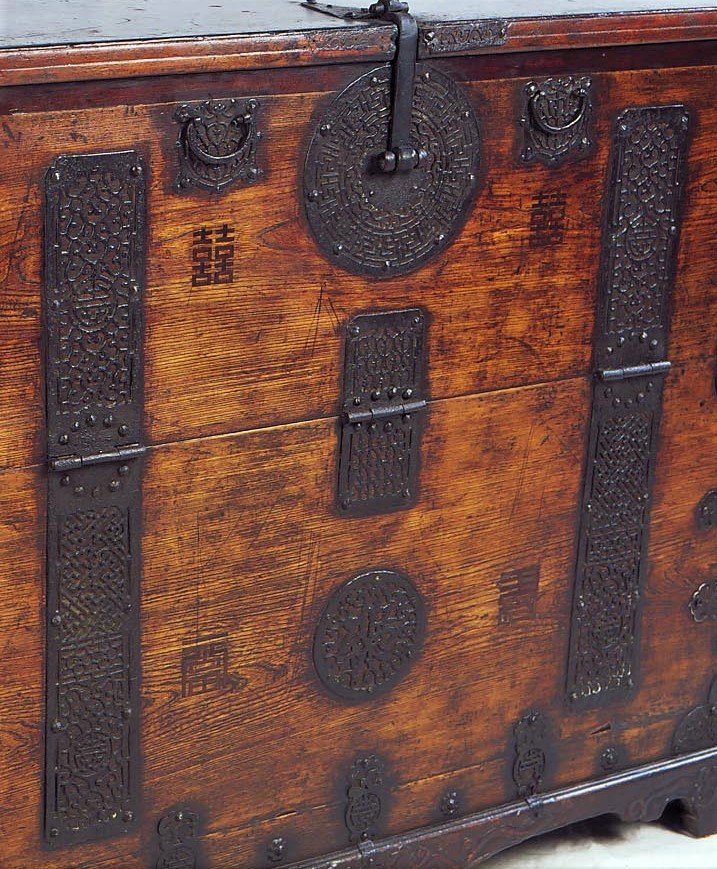
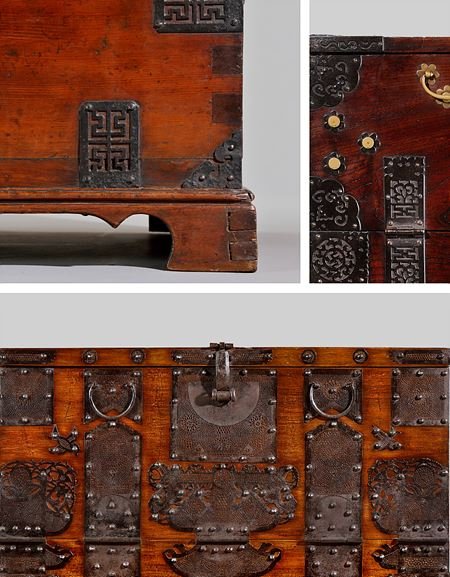
BANDAJI – BLANKET CHEST – 반닫이
Elm wood front, Pine back and sides. Iron fittings.
Pakchon area, Pyongan Do province. Late 19th century.
H. 103cm, W. 107cm, D. 47cm.
The metalwork is finely wrought and unusually thick.
The central metal piece is a South Gate motif.
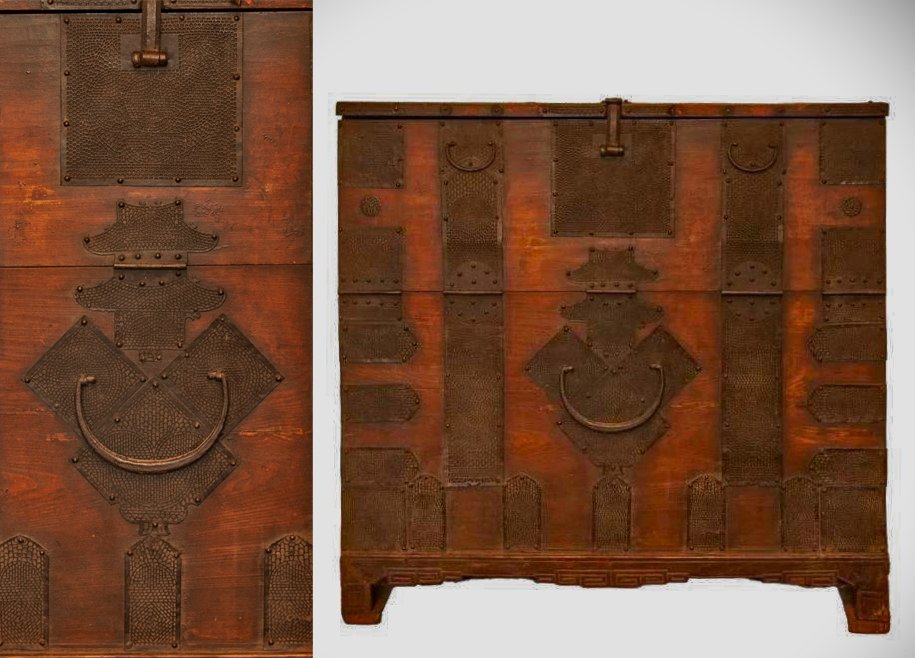
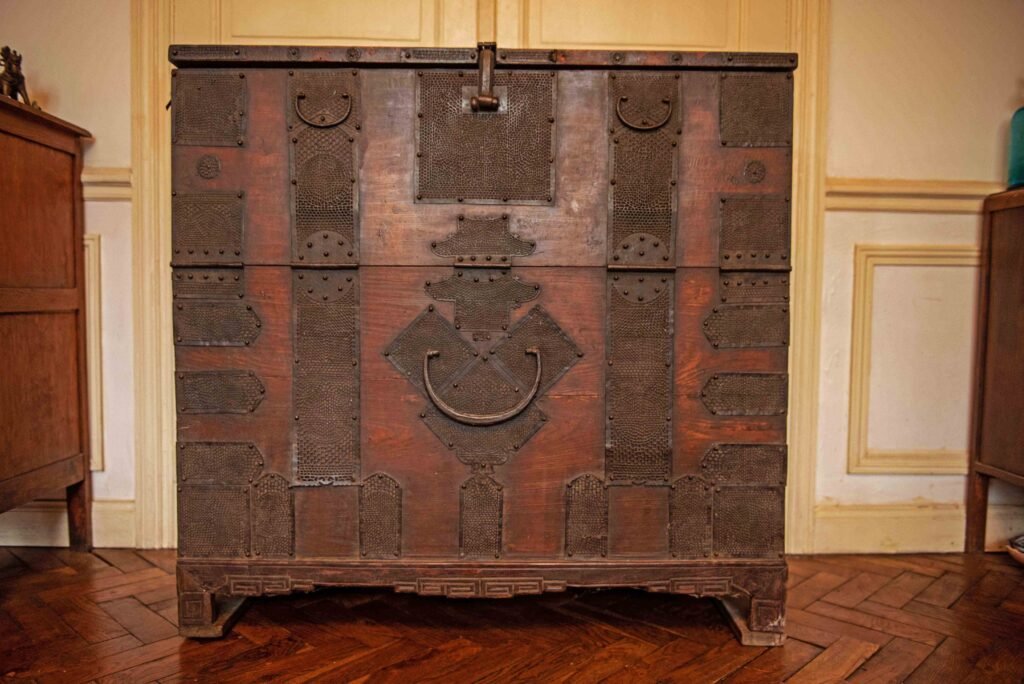
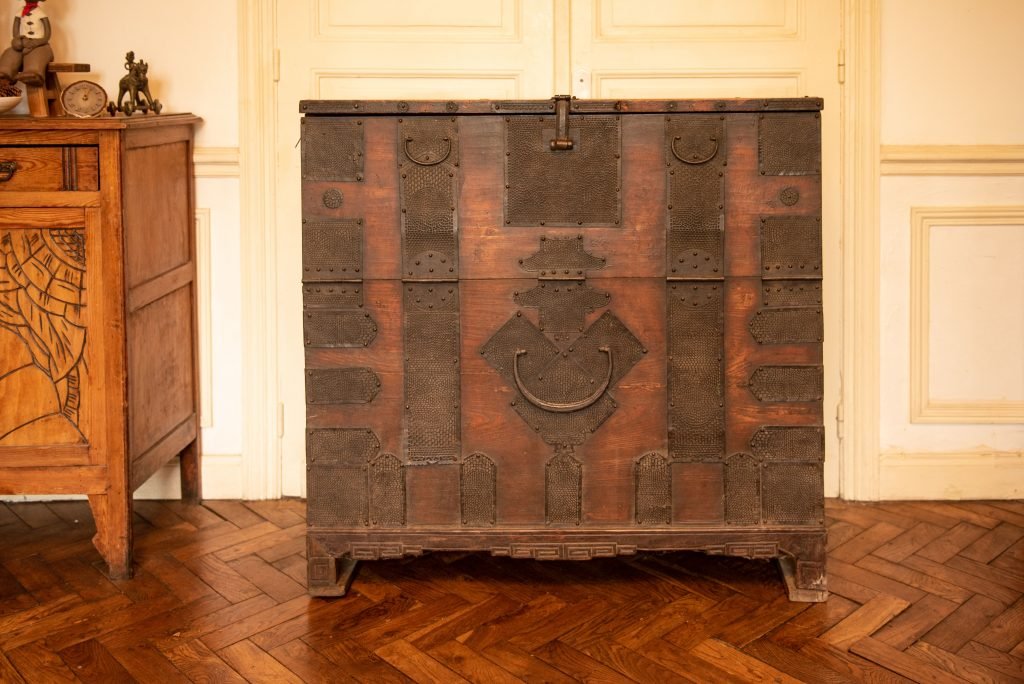
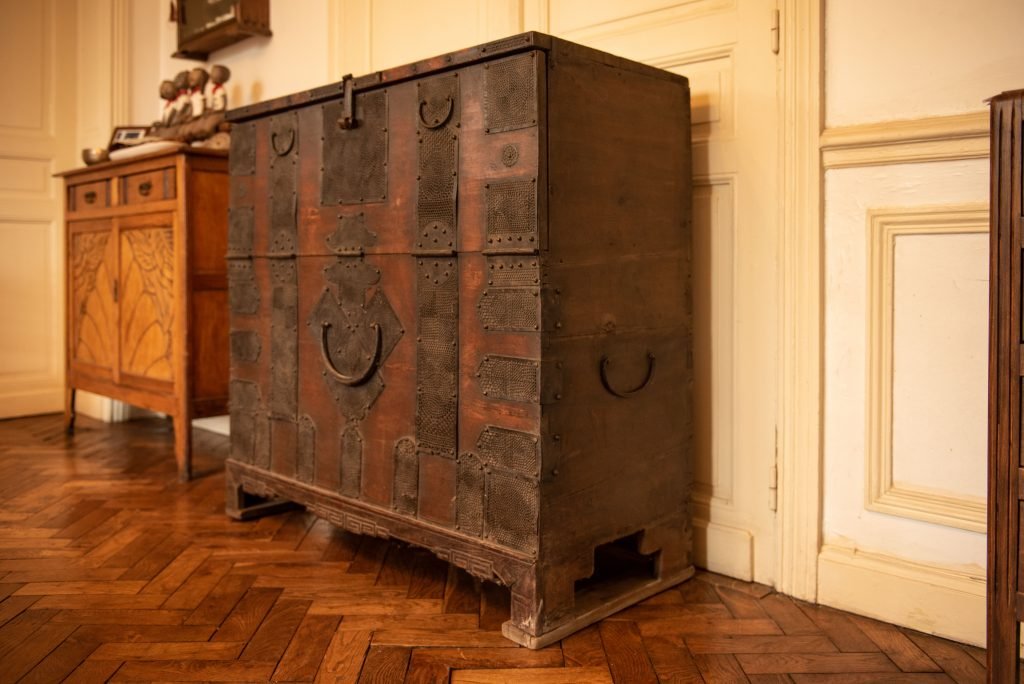
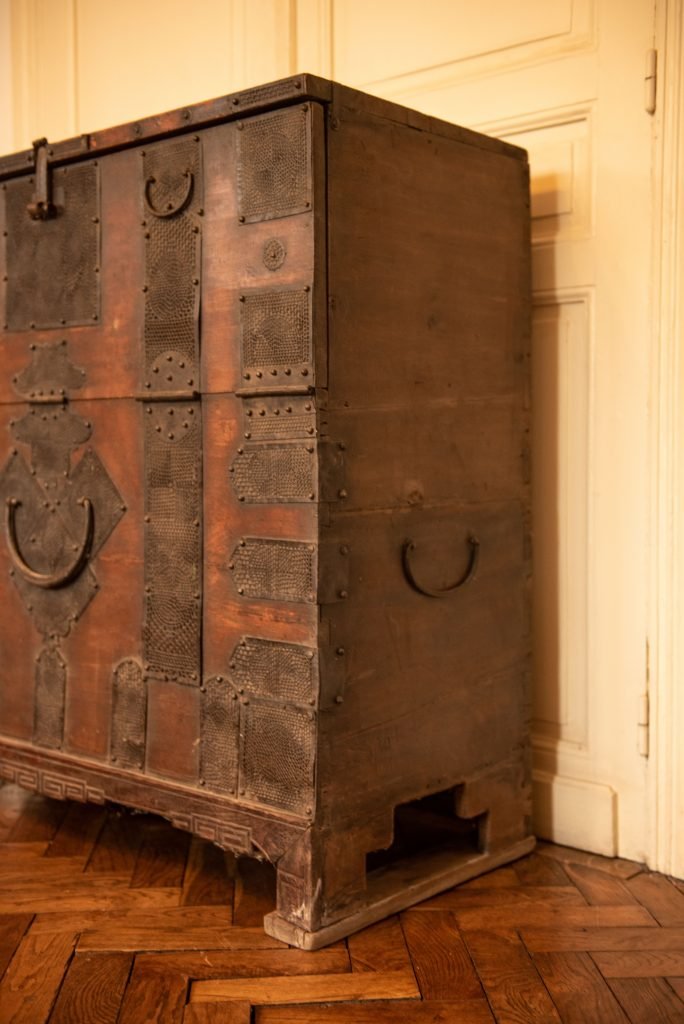
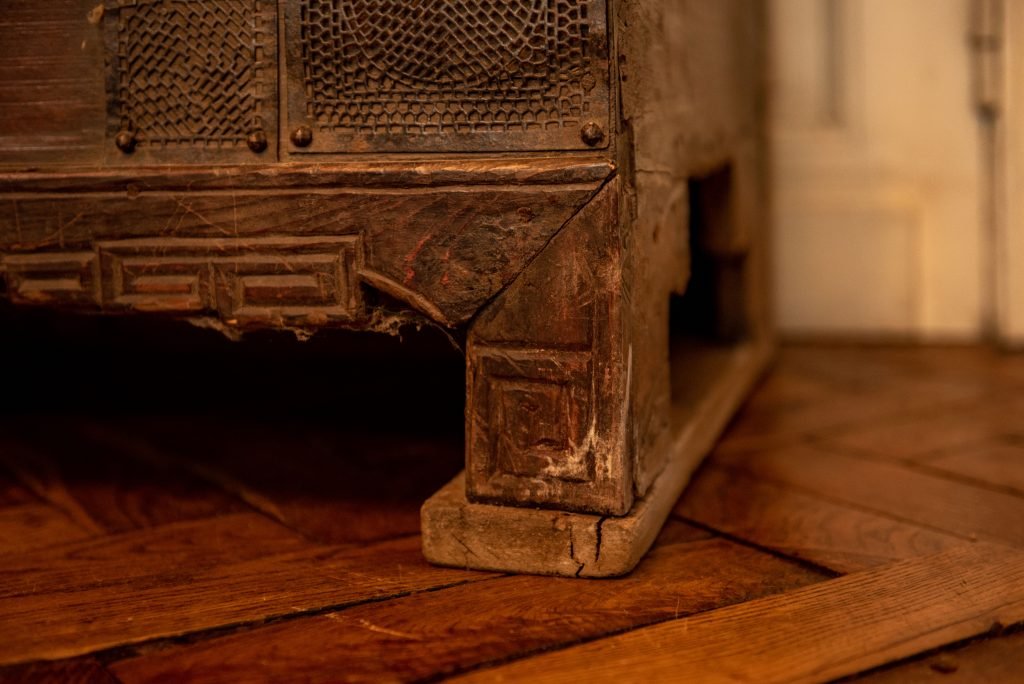
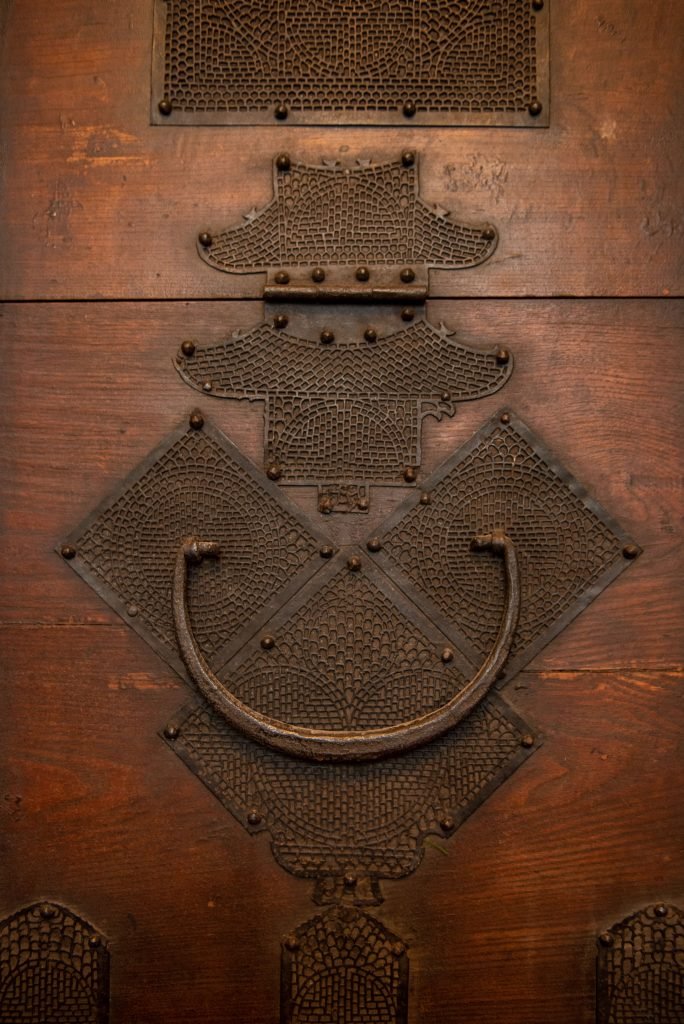
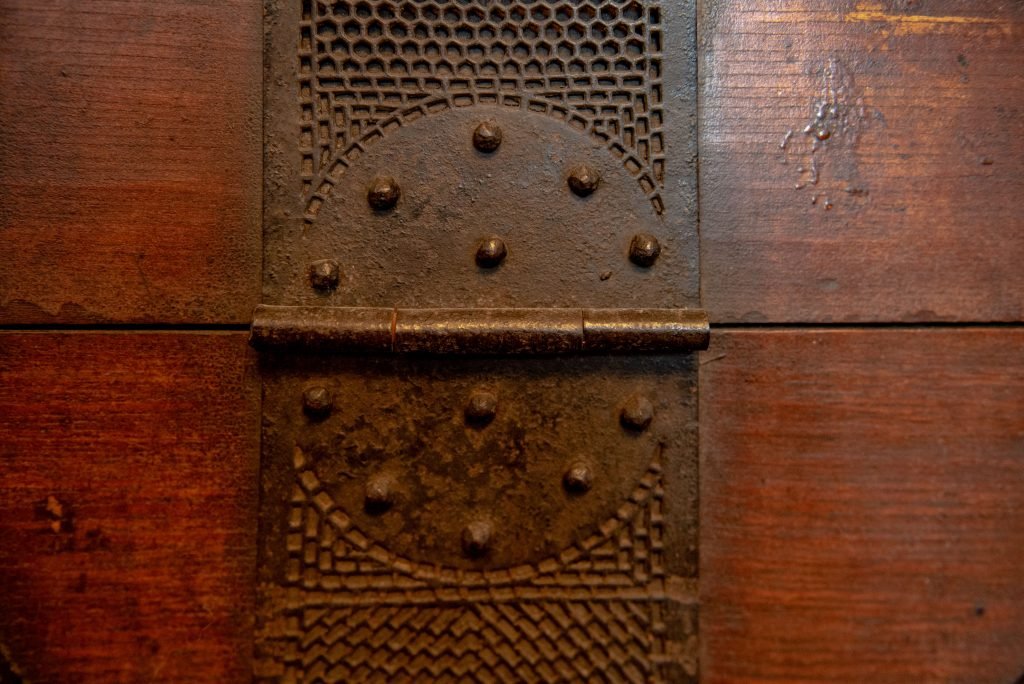
BANDAJI – BLANKET CHEST – 반닫이
Korean ash wood front part, pine wood top, sides, back & bottom. Iron fittings, oil finish.
Gyeonggi Province. Mid 19th Century.
H. 63 cm, W, 92 cm, D. 46 cm.


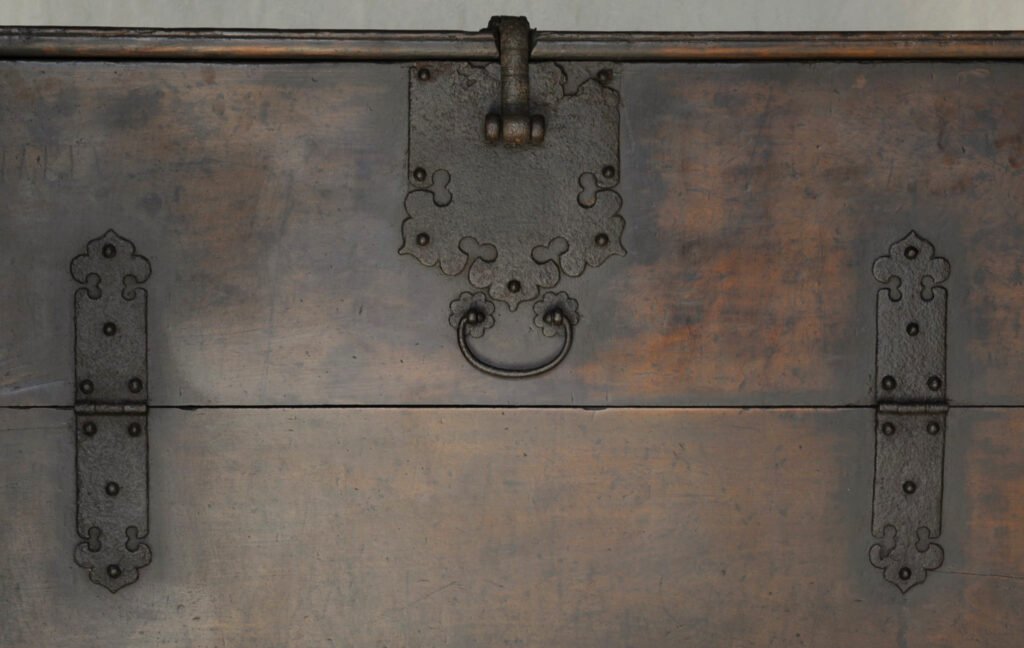
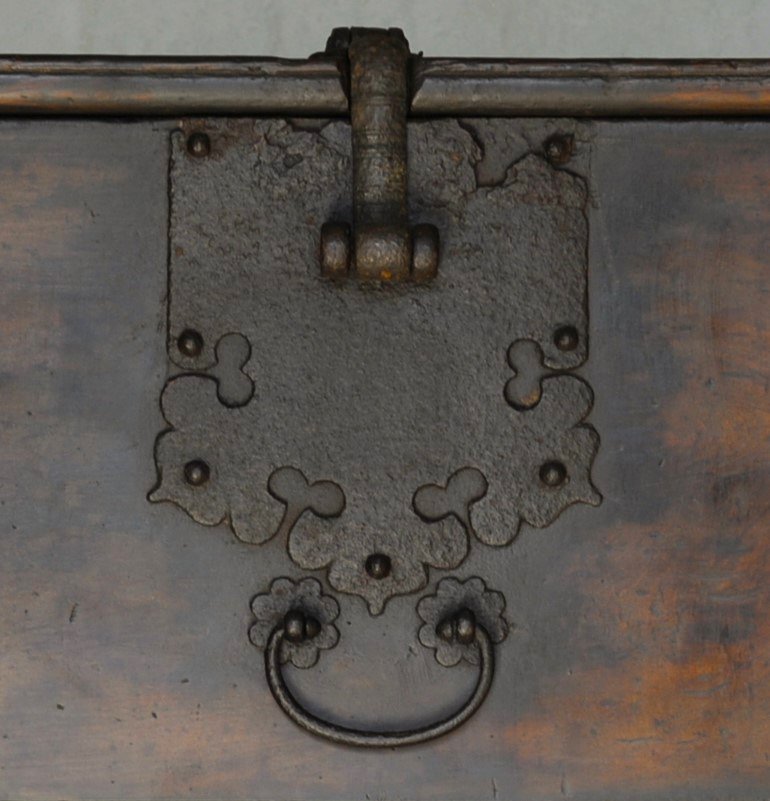
BANDAJI – BLANKET CHEST – 반닫이
Red pine wood, iron fittings, oil finish. Late 19th century. H. 69cm, W. 98cm, D. 48cm.
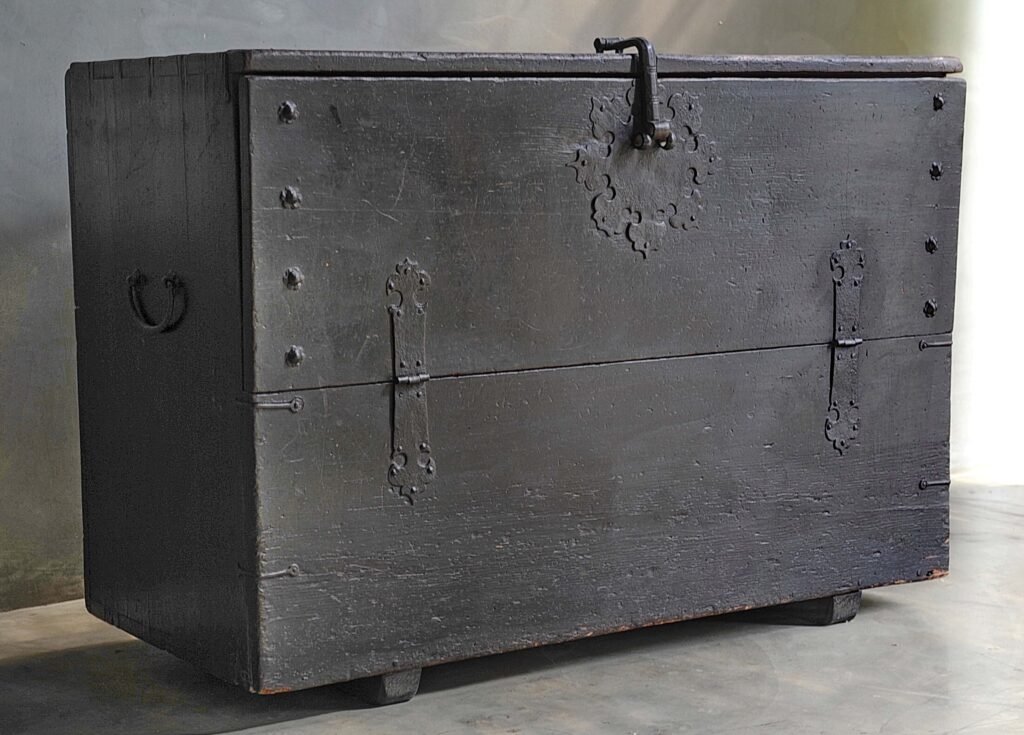
BANDAJI – BLANKET CHEST – 반닫이
Red pine wood, iron fittings, oil finish.
Gyeongsang province. Late 19th century.
H. 83cm, W. 114cm, D. 47cm.
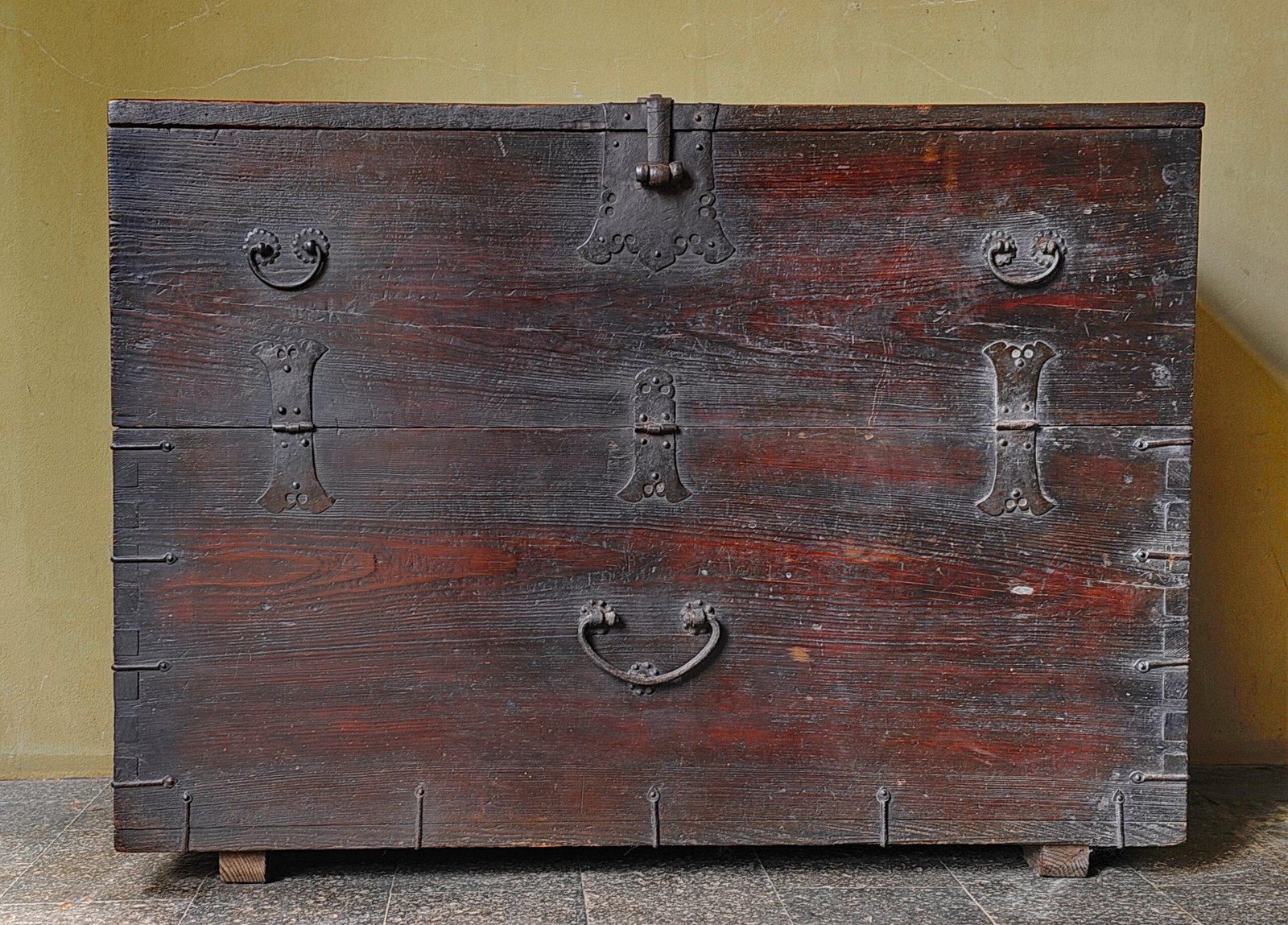
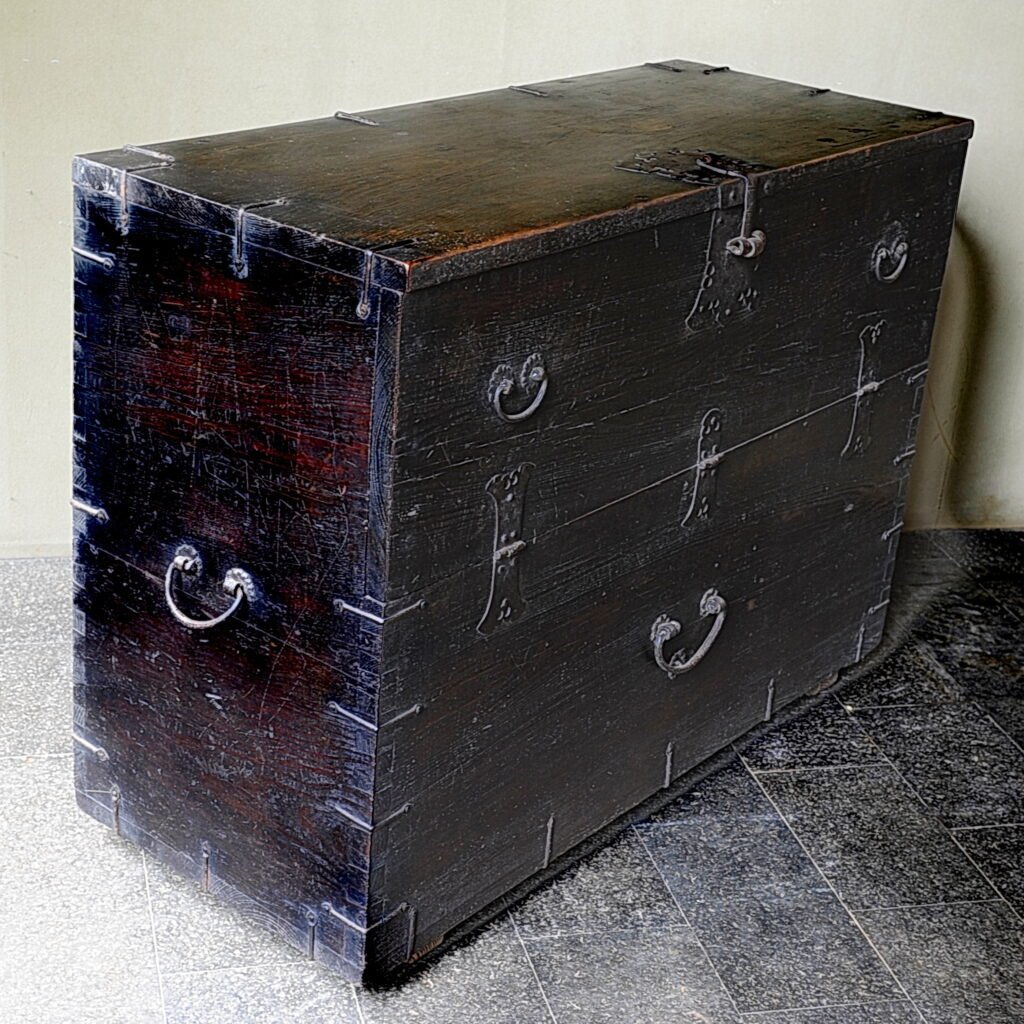
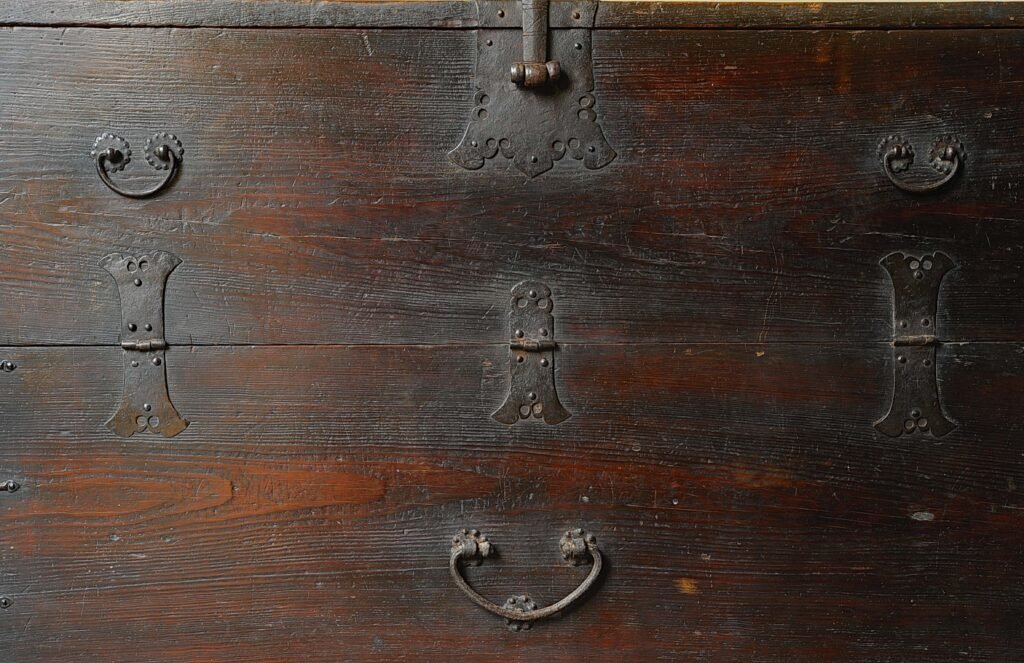
BANDAJI – BLANKET CHEST – 반닫이
Cut paper on wood, iron fittings. Gyeonggi province.
Mid 19th century. H. 82cm, W. 88cm, D. 48cm.
The entire front surface of this Bandaji is covered with cut-paper applique stimulating a type of fittings popular on Sung Sun I Bandaji from North Korea. Pieces of this kind are hard to find now days.
The South gate motif is clearly visible in the center of the chest.


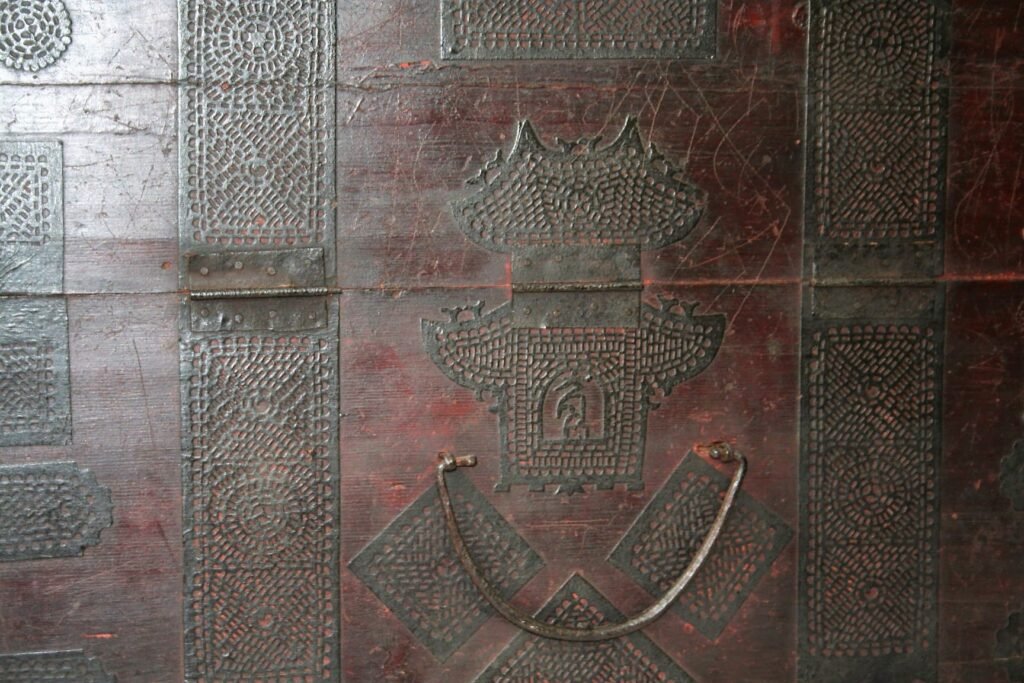
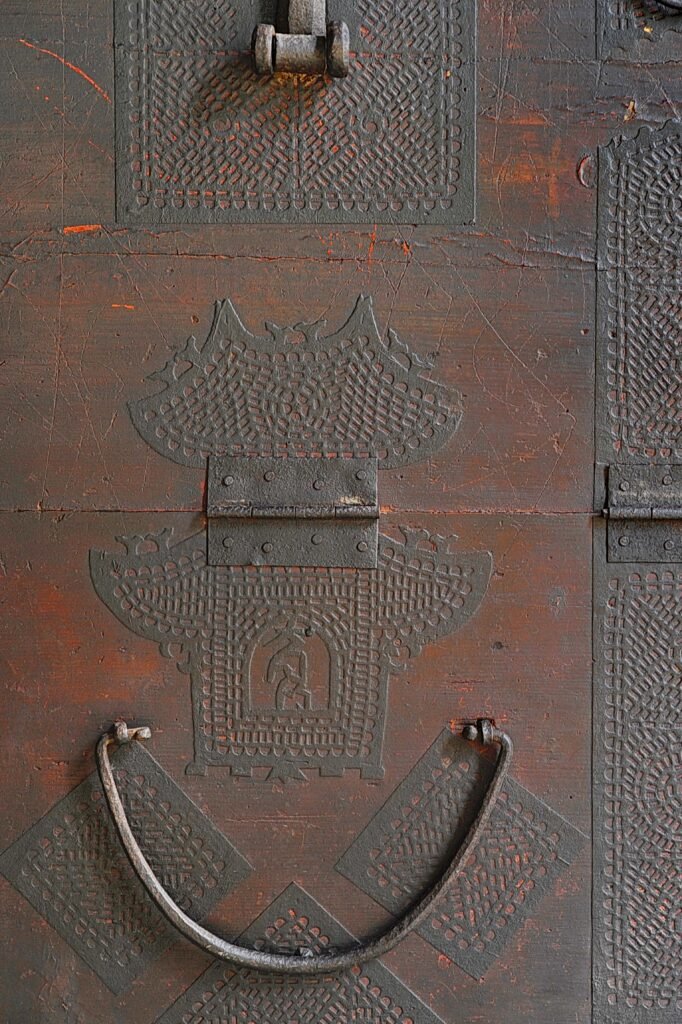
BANDAJI – BLANKET CHEST – 반닫이
Late 19th century. Original condition
Oak wood front, top, bottom and sides. Red pine wood back. Iron fittings Gyeonggi province.
H. 71cm, W. 99cm, D. 48cm
Top construction of this chest consist of an overhanging board.


BANDAJI – BLANKET CHEST – 반닫이
Red pine wood, iron fittings, Southern part of the Pyongyang province near Hwanghae province..
Mid 19th Century.
H. 70cm, W. 80cm, D. 40cm.
Very fine small blanket chest made from thin wooden panels.
Iron work on this piece is finely incised and very similar to chests from the Northern part of the peninsula.
Metalwork decorative patterns includes the bat drawer pullers, longevity characters on door hinges as well as “Manja” patterns on corner pieces.
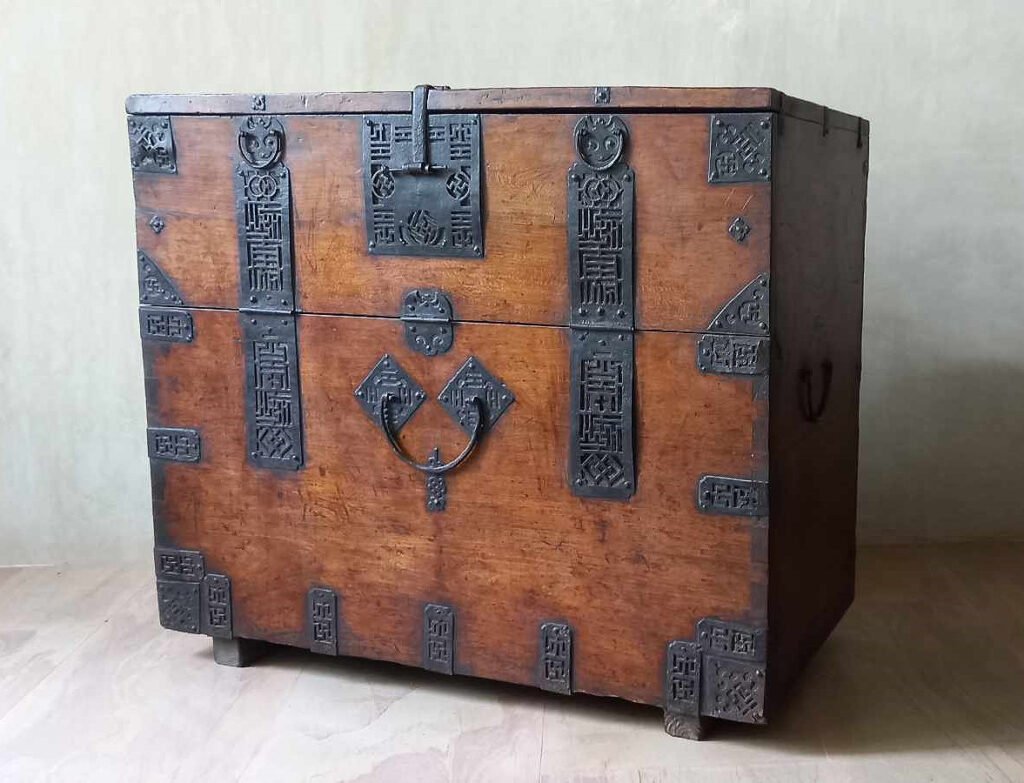

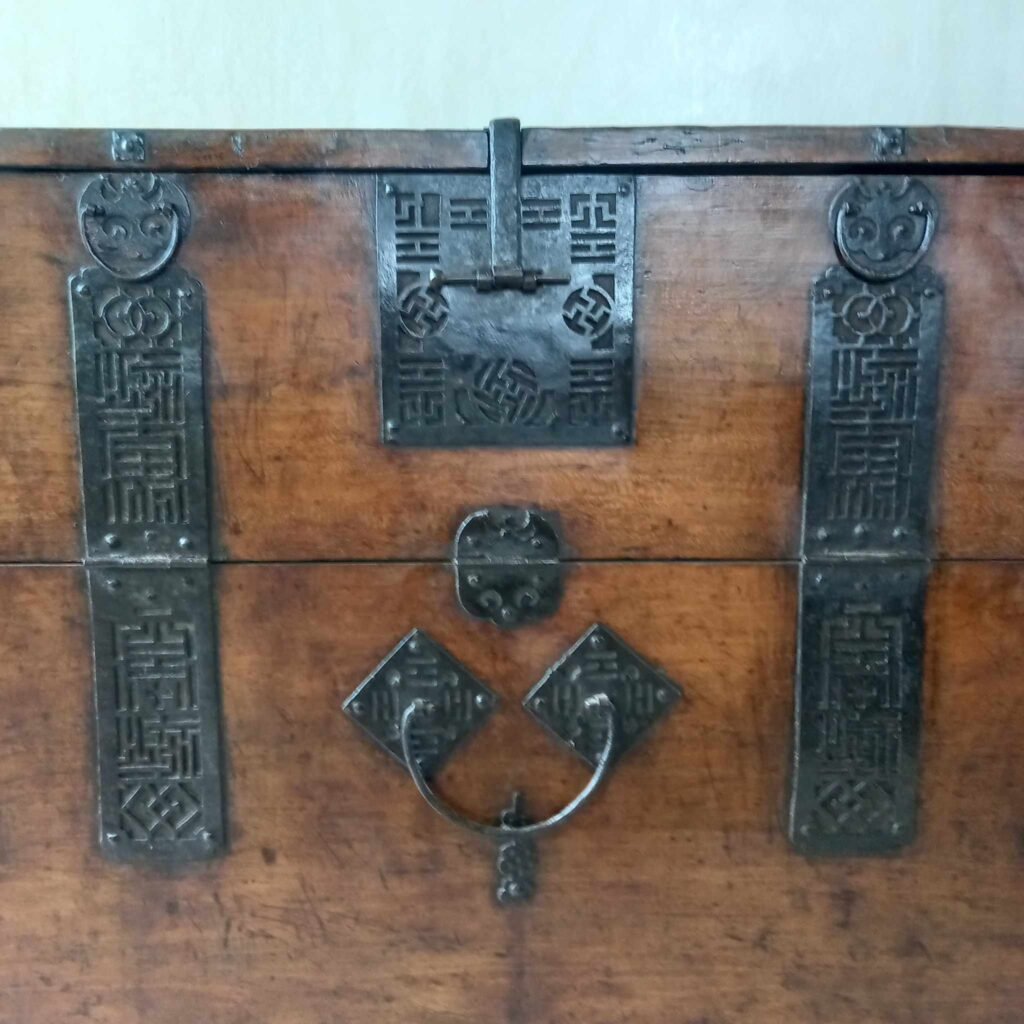
BANDAJI – BLANKET CHEST – 반닫이
Pear wood, iron fittings, oil finish. Early 20th century, Jeju island. H. 73cm, W. 84cm, D. 44cm.
Typical design from Jeju island with three large front fittings holding the opening panel. this chest is entirely made from pear wood, a wood seldom used on bandaji to the risks of cracking. The inside was covered with printed paper.
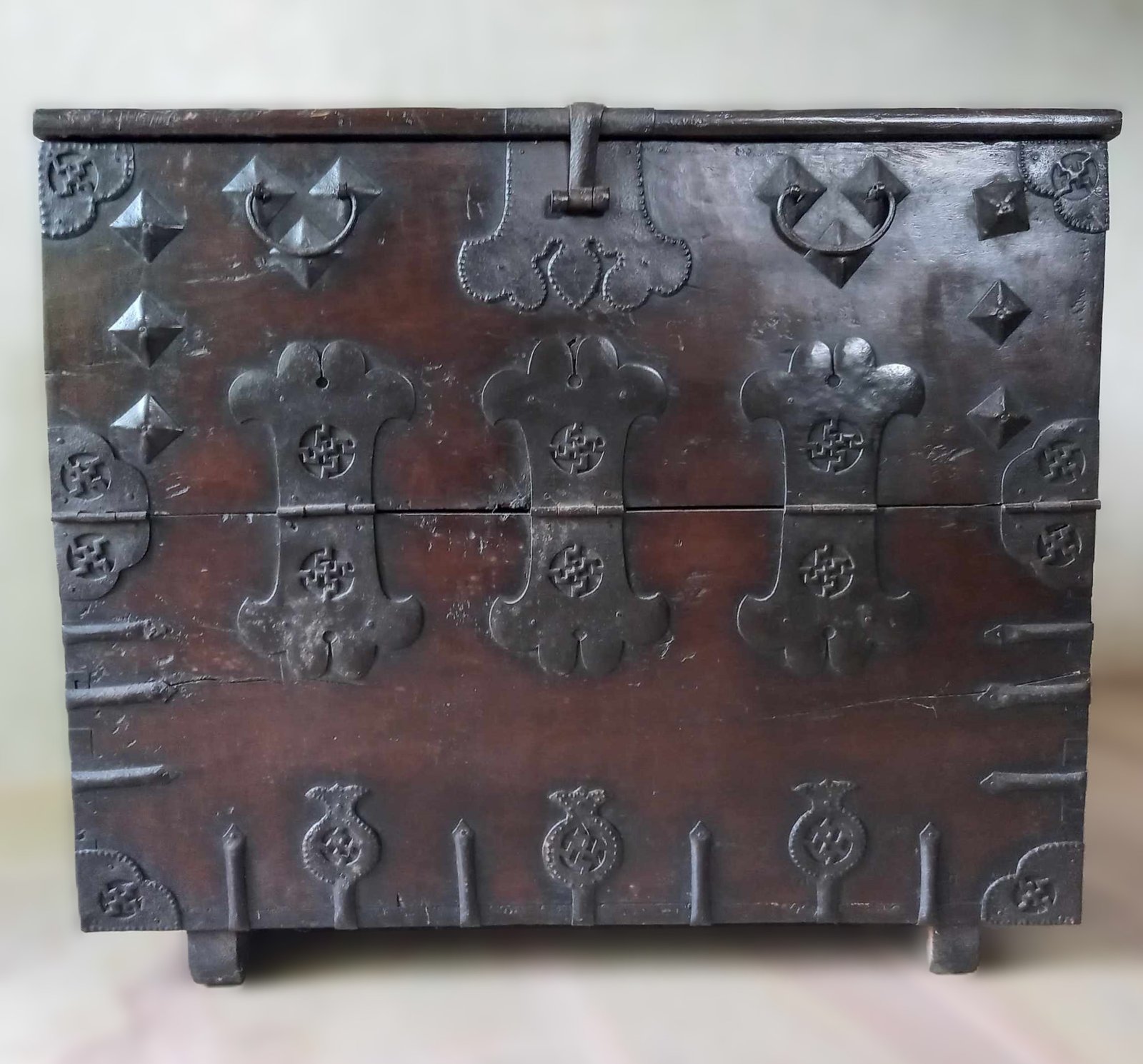
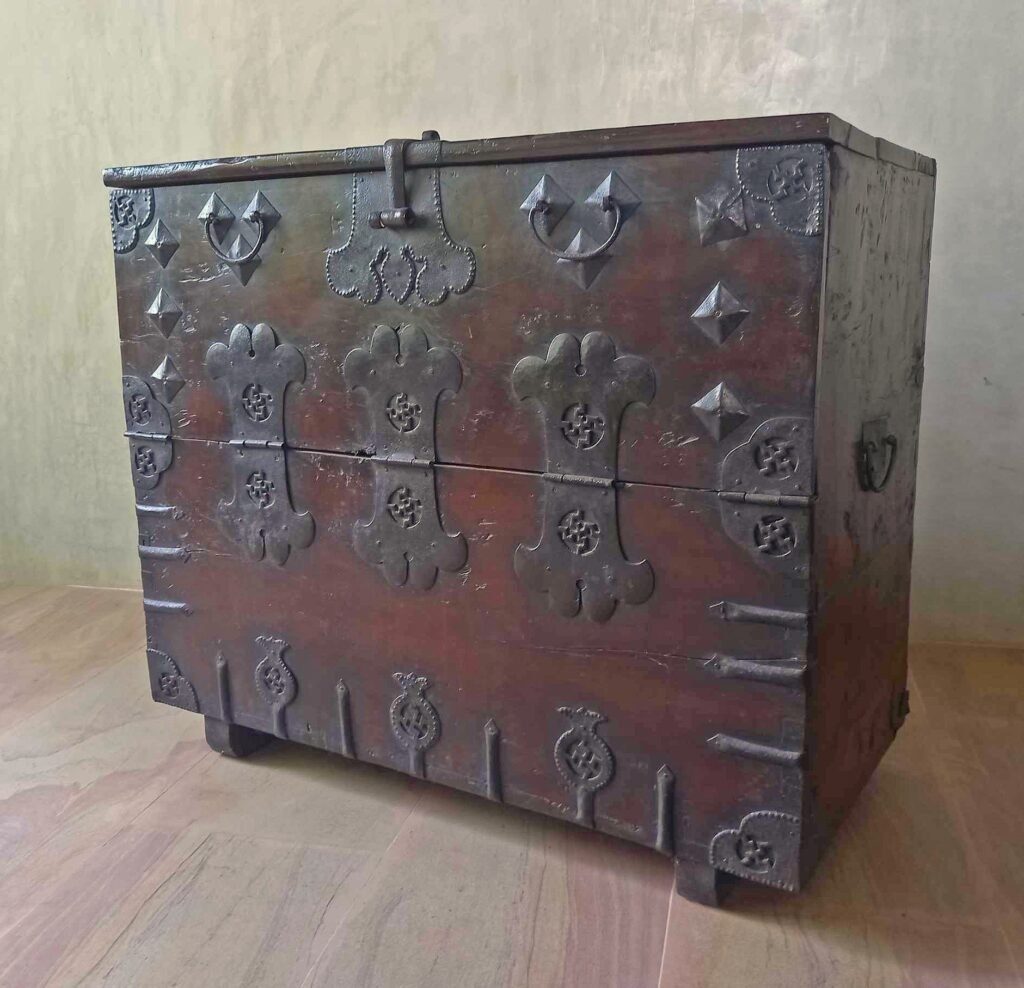


BANDAJI – BLANKET CHEST – 반닫이
Red pine wood, iron fittings, oil finish. Jeolla province. Late 19th century. H. 79cm, W. 110cm, D. 50cm.
This piece is called a “GOCHANG” bandaji named after its area of origin. It is smaller than the usual dimension. Iron fittings decoration is easy to recognize. The central lock plate is round. The opening front panel is fixed by fasteners in swallowtail shapes and there is always a square decorative fitting place in the middle lower part of the chest. The bat motif is widely used for furniture handles.
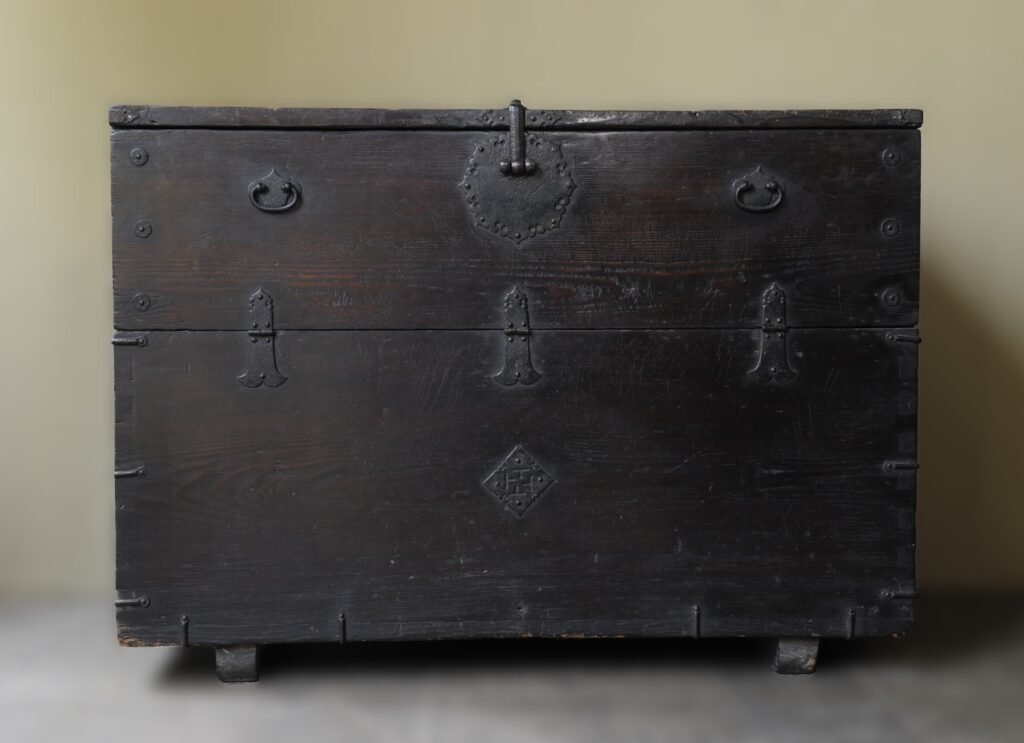
BANDAJI – BLANKET CHEST – 반닫이
Red pine wood, iron fittings, Oil finish. Three drawers in a bottom compartment. Gangwon Province.
Mid 19th Century. H. 106 cm, W. 106 cm, D. 46 cm.
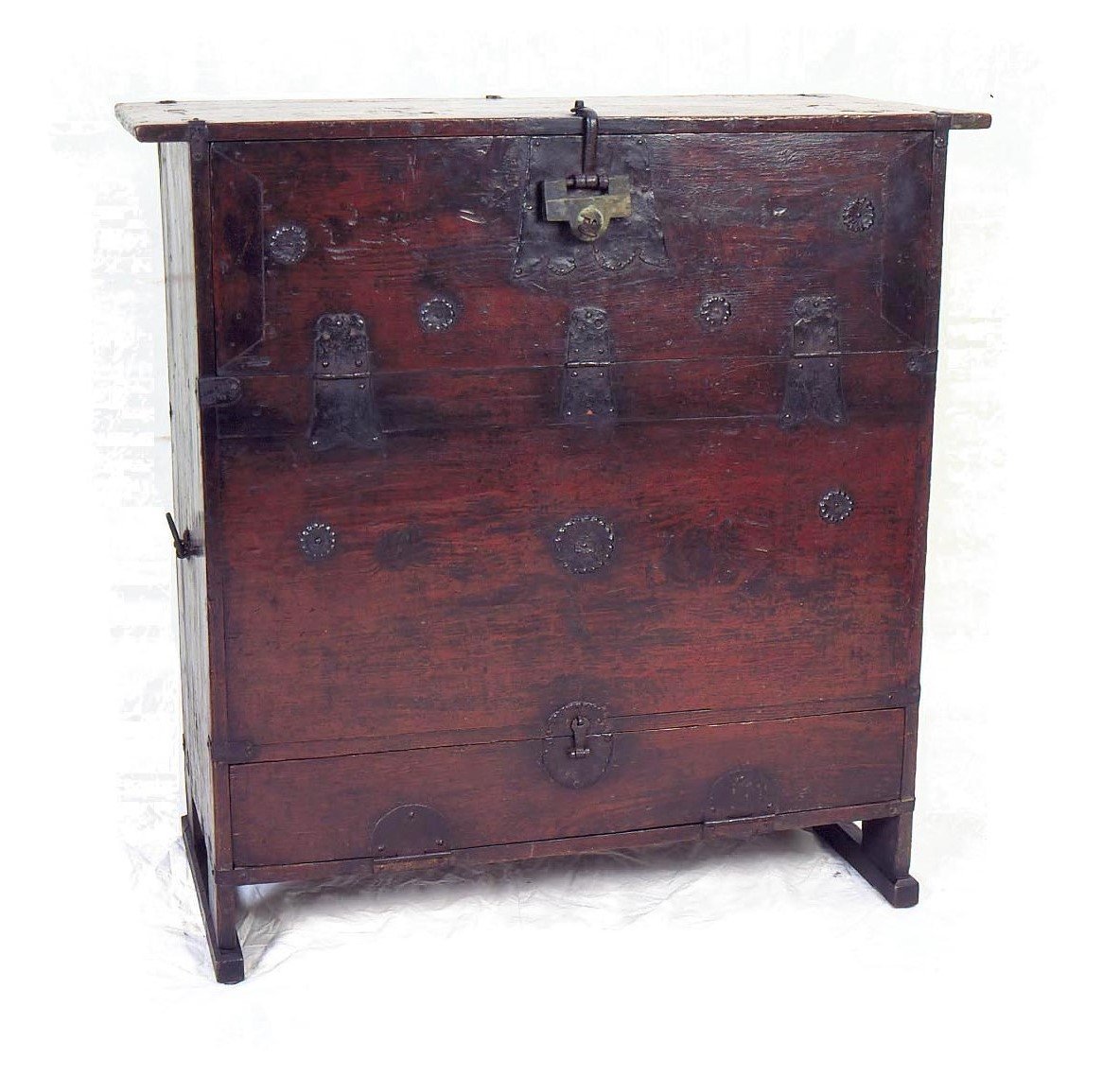
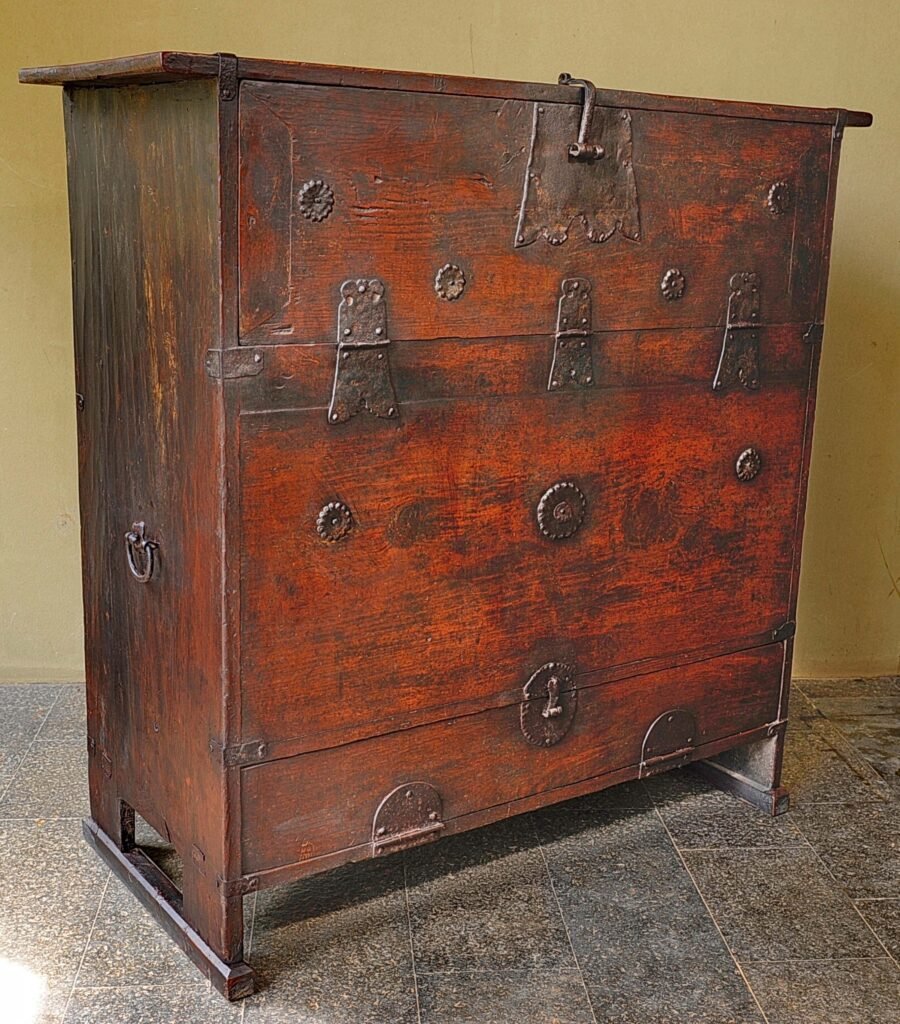
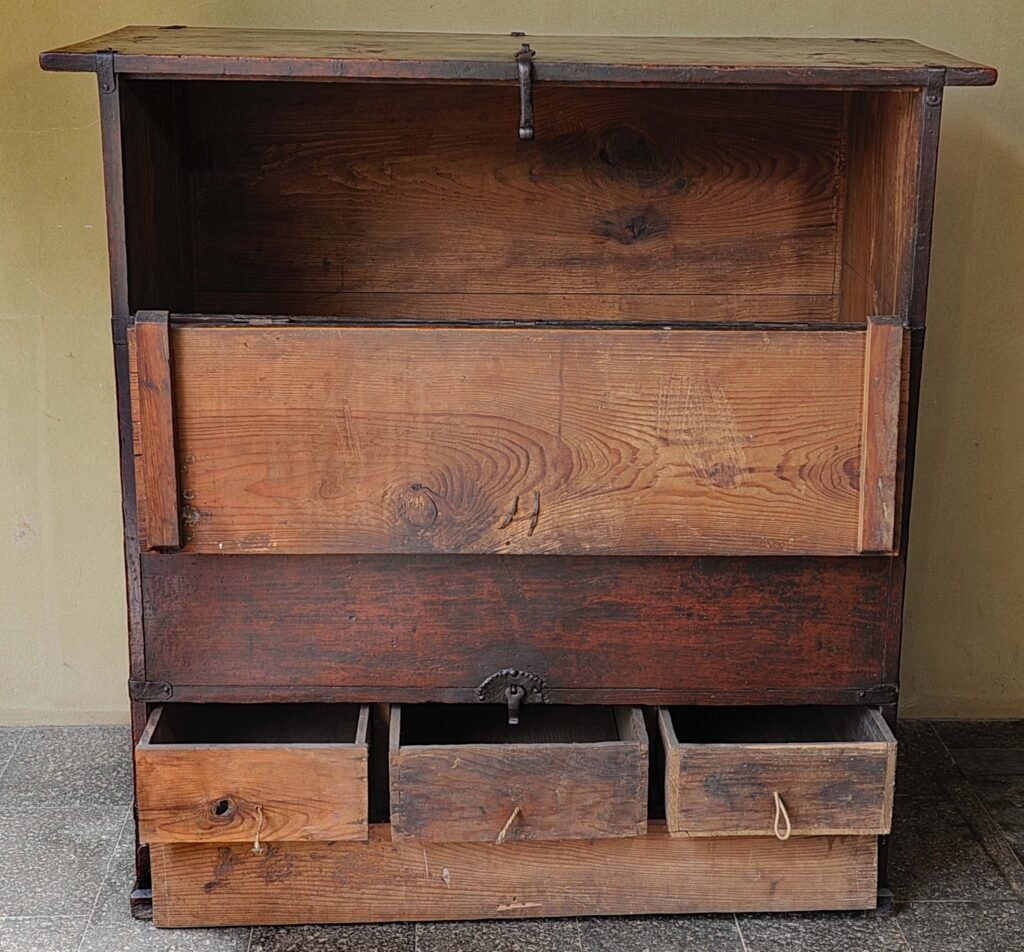
ICH’UNG NONG – STACKABLE CLOTHING CHEST – 이층농
Two units stacked chest. Paulownia wood, iron fittings. Oil finish. Legs restored.
Mid 19th century. Gyeonggi province. H. 112cm, W. 77cm, D. 39cm.
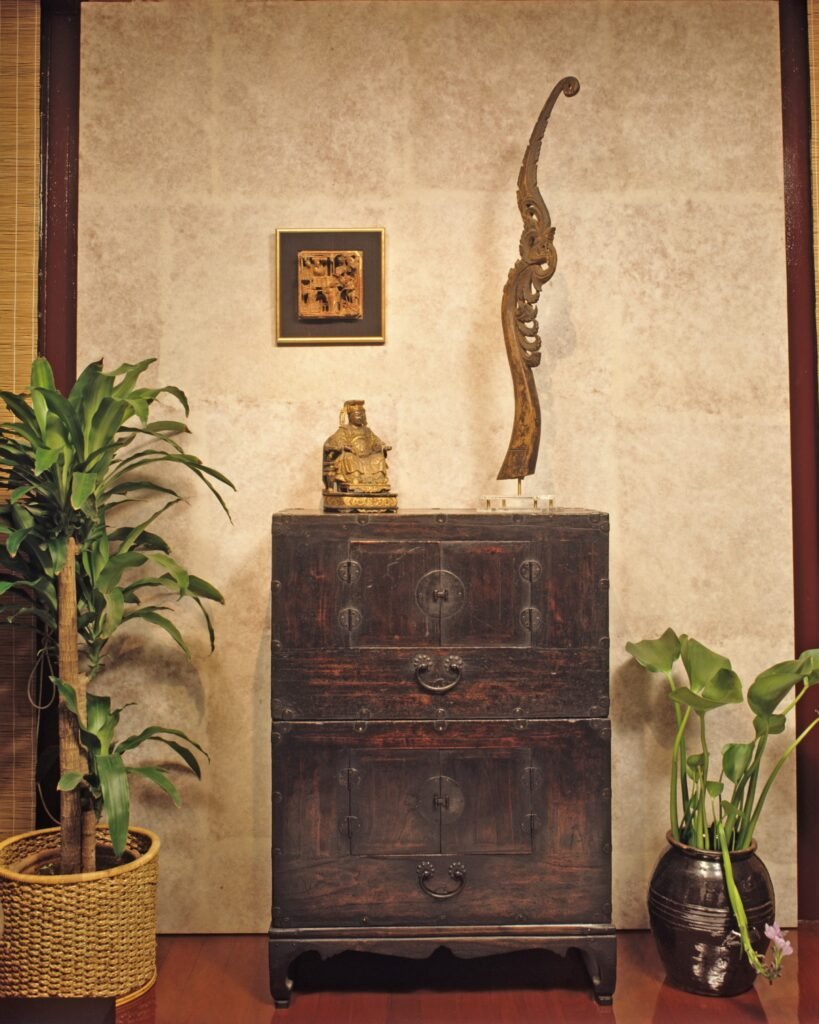
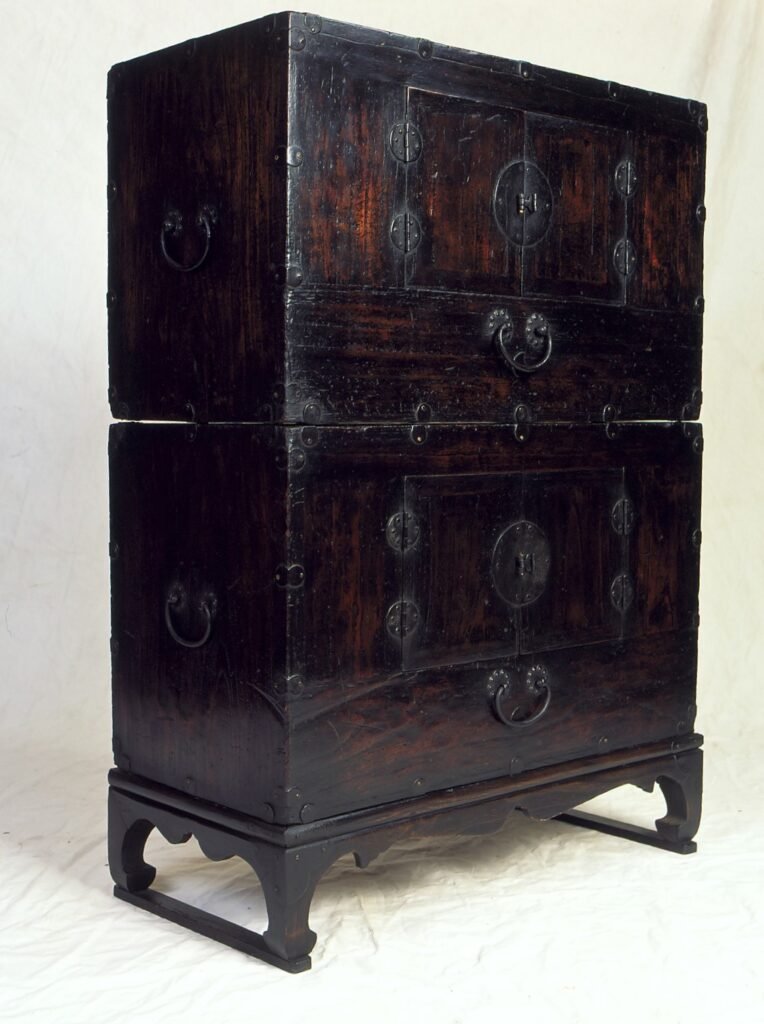
This Nong is a relatively hard-to-find piece these days. The dark finish, which beautifully reveals the wood’s grain, was likely achieved using the “Nakdong” method.
This ancient wood treatment process involves the application of heat. The method entails removing the soft wood fibers by rubbing the wood’s surface with rice straw and burning it, leaving behind only the hard grain. When applied to paulownia wood, this process reveals a rich, dark brownish-black color, enhancing the wood’s beautiful grain. The treated surface is then coated with natural oil. This technique enhances the wood’s resistance to fire, insects, and fungal damage. It is akin to the Japanese practice known as “shou sugi ban” (焼杉板), primarily employed on cedar wood, which has been in use in Japan since the 18th century.
A very similar piece is part of the collection of the Weisman Art Museum in Minneapolis, Minnesota, USA, and has been featured in the book “Korean Furniture: Elegance & Tradition” by Edward Reynolds Wright & Man Pai.
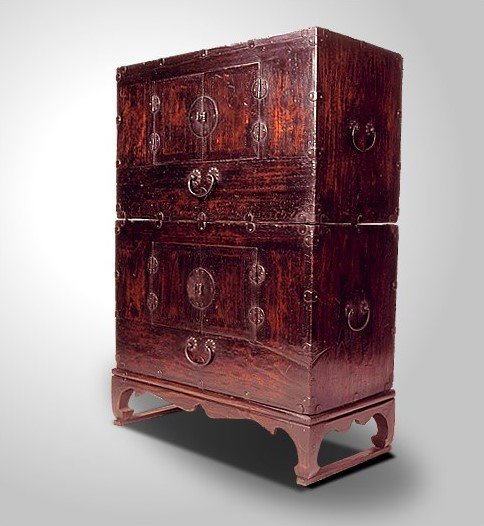
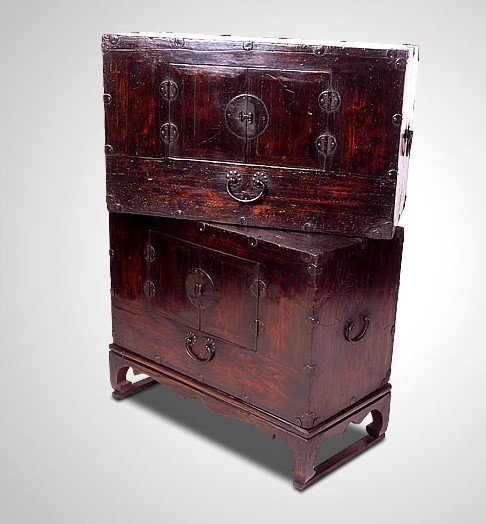
ICH’UNG NONG– STACKABLE CLOTHING CHEST – 이층농
Two units stacked chest, Paulownia and pine wood body,
ash wood front panels, zelkova wood frame,
persimmon wood inlaid, yellow brass fittings.
Early 19th century. Gyeonggi province.
H. 123cm, W. 80cm, D. 39cm.


UIGORI JANG – 의걸이장
Pine & paulownia wood, white brass fittings. Early 20th century, Gyeonggi province. H 184cm, W. 86cm, D. 43cm.

SAMCH’UNG JANG – THREE LEVEL CHEST – 삼층장
Paulownia & Pine wood body, pear wood frame (front) Korean ash wood panels (front), persimmon wood inlay. Yellow brass fittings. Late 19th century. Gyeonggi province. H. 166cm, W. 110cm, D. 50cm.
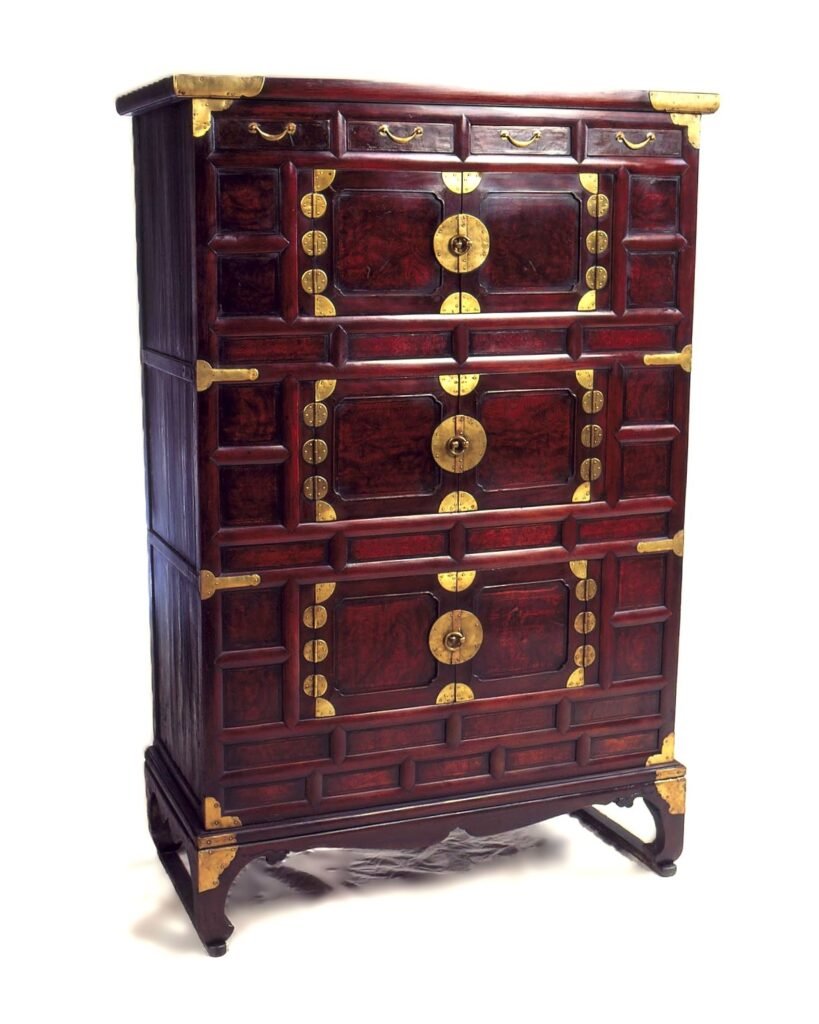
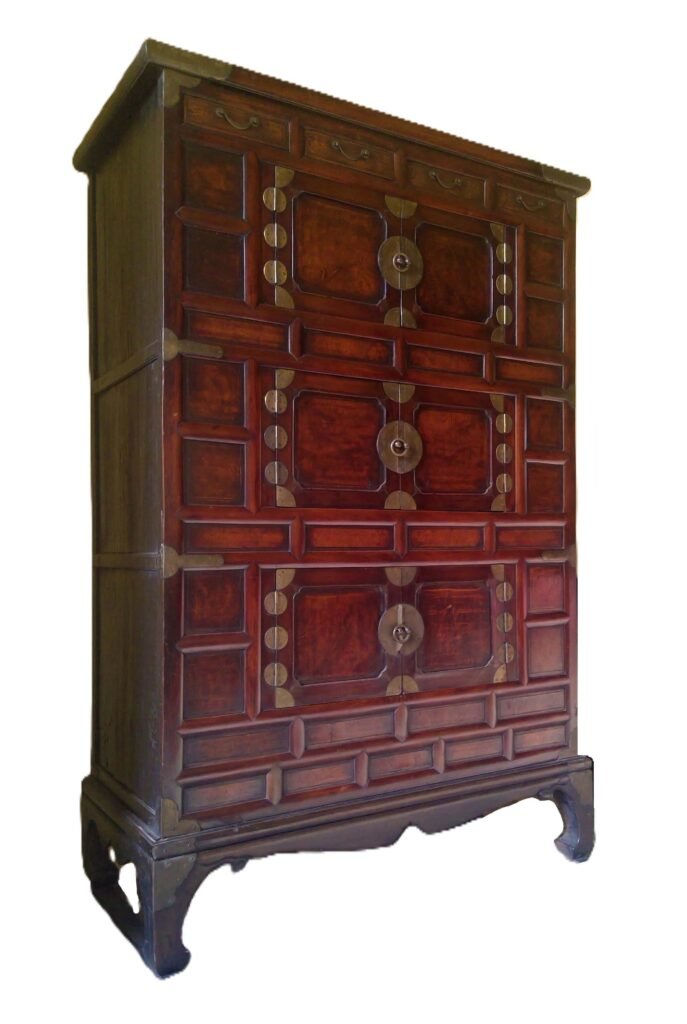
CH’AEKJANG – BOOKCHEST – 책장
Two levels with double doors top part & sliding doors bottom part. Pine & elm wood. Dark stain finish, iron fittings. Mid 19th century, Gyeonggi province. H 126cm, W. 110cm, D. 58cm.
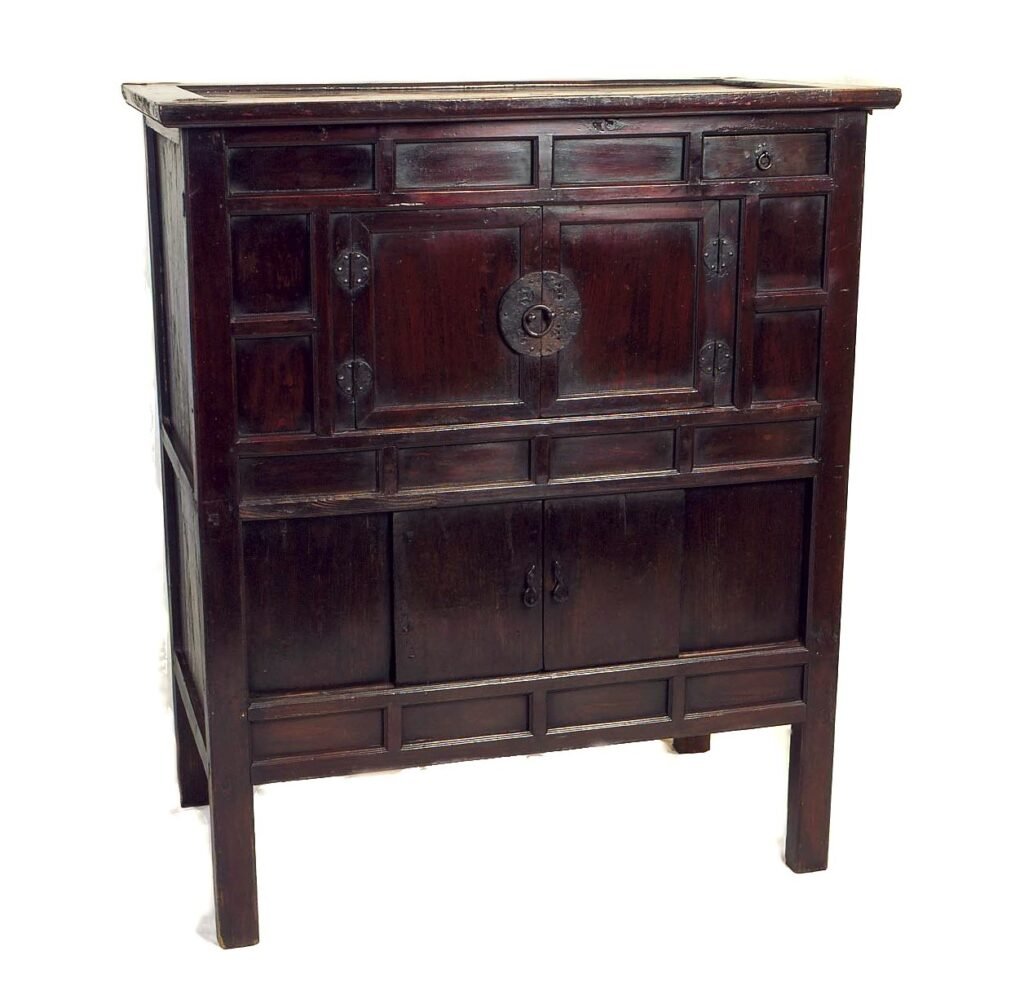

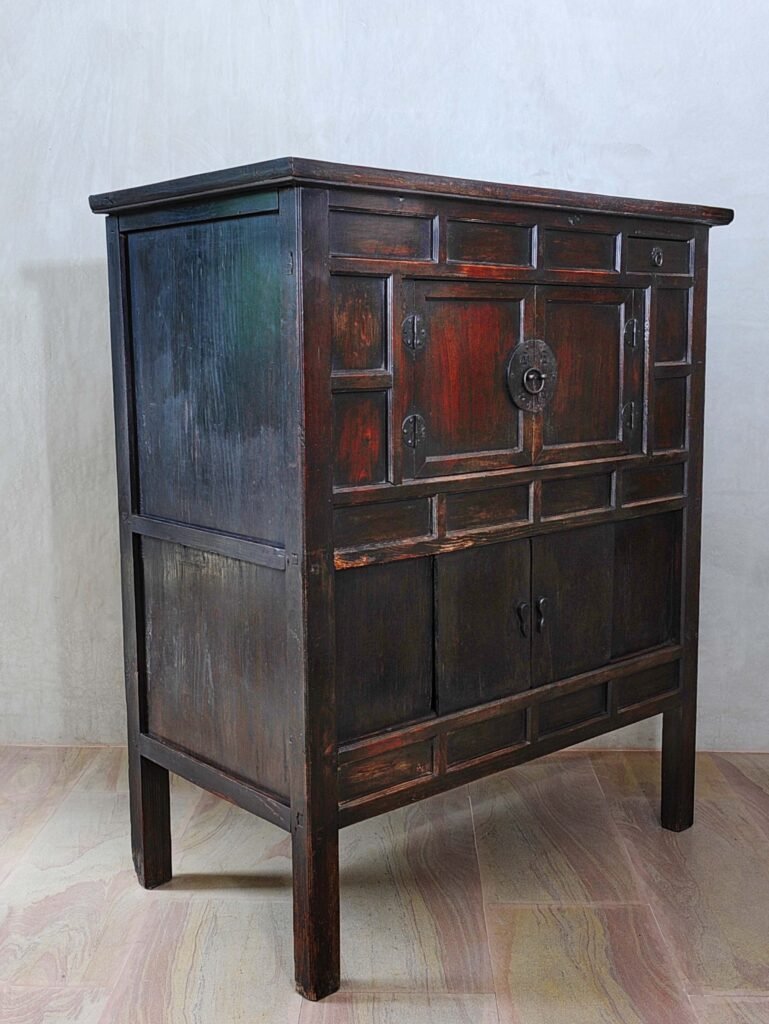
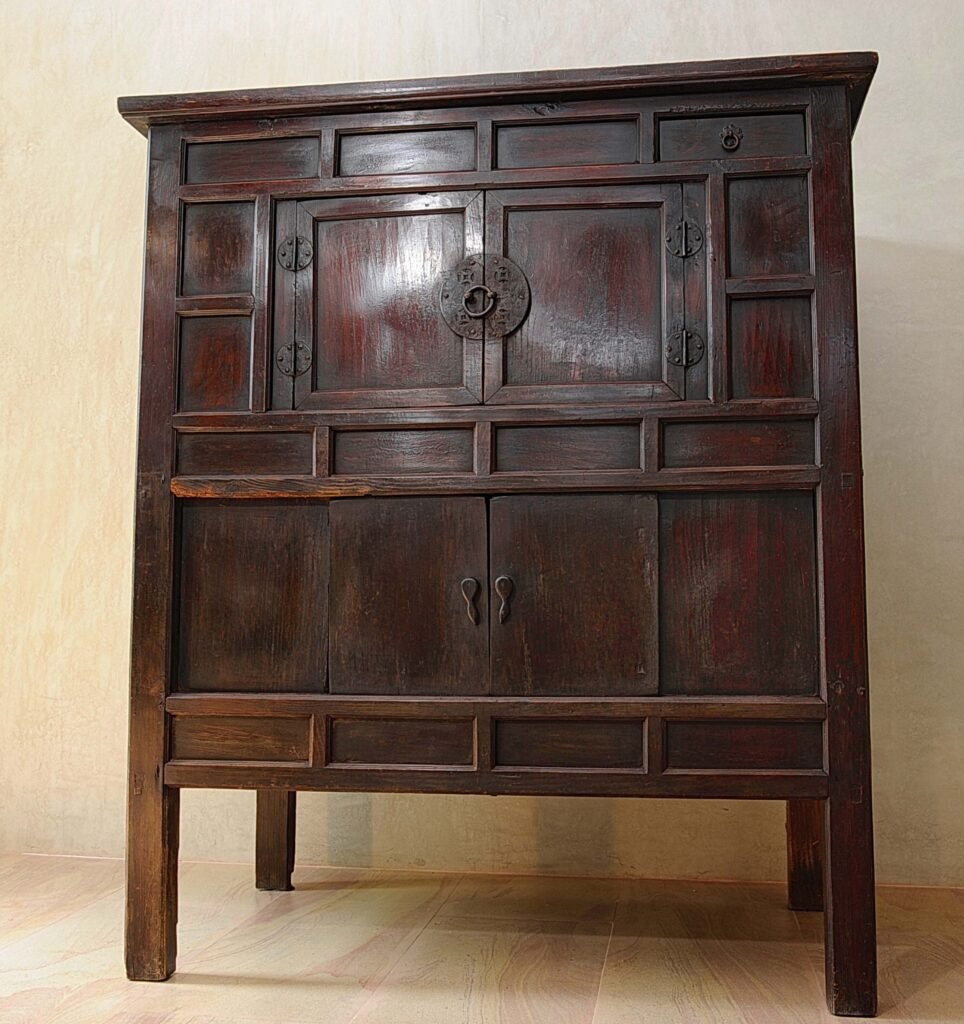

TUIJU-JANG – RICE CHEST – 뒤주
Pine wood, iron fittings, oil finish. Mid to late 19th Century. Ch’ ungcheong Province. H. 121 cm, W. 116 cm, D. 57 cm.
This sizable piece of furniture is constructed with two levels. The upper level was typically utilized for storing rice or grains, while the lower level, equipped with doors, was designated for storing kitchen accessories.
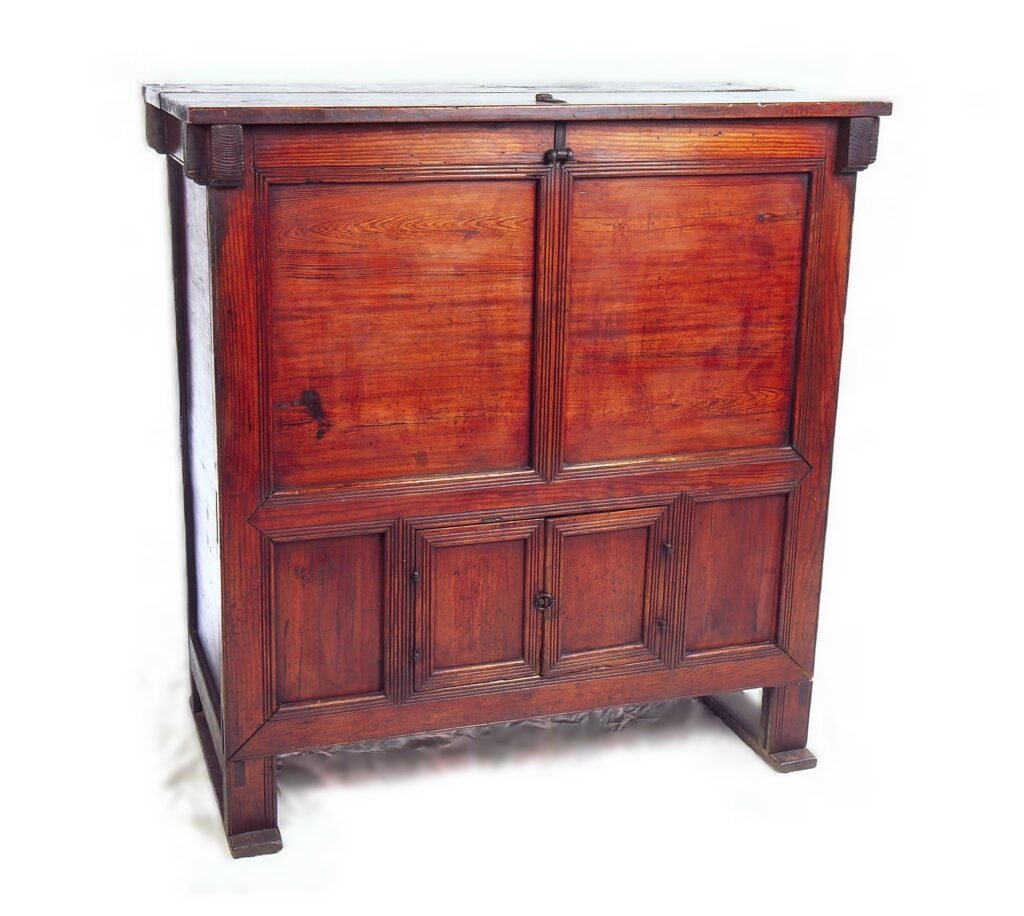
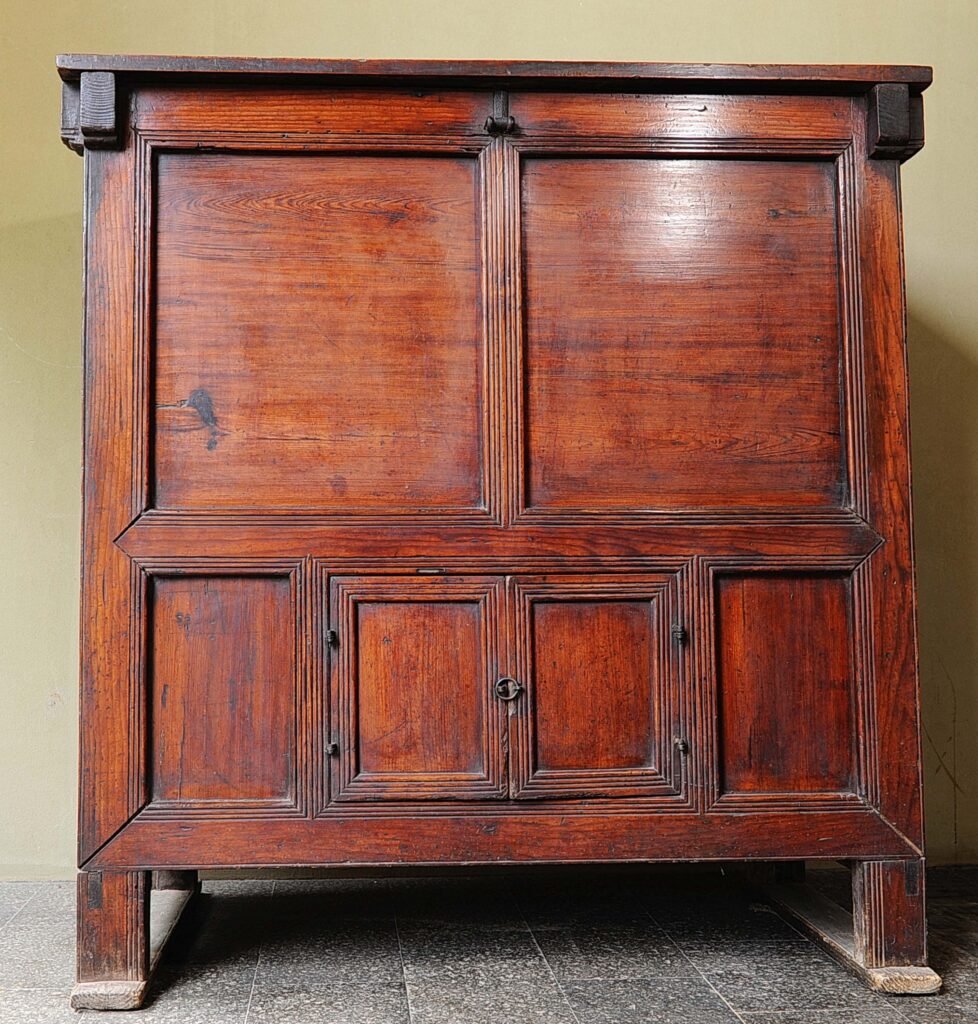

TUIJU-JANG – RICE CHEST – 뒤주
Pine wood, iron fittings, oil finish. Gyeonggi Province. Late 19th century. H. 69 cm, W. 95 cm, D. 60 cm.
The dimension of this piece is unusual as most Korean rice chests are much higher.
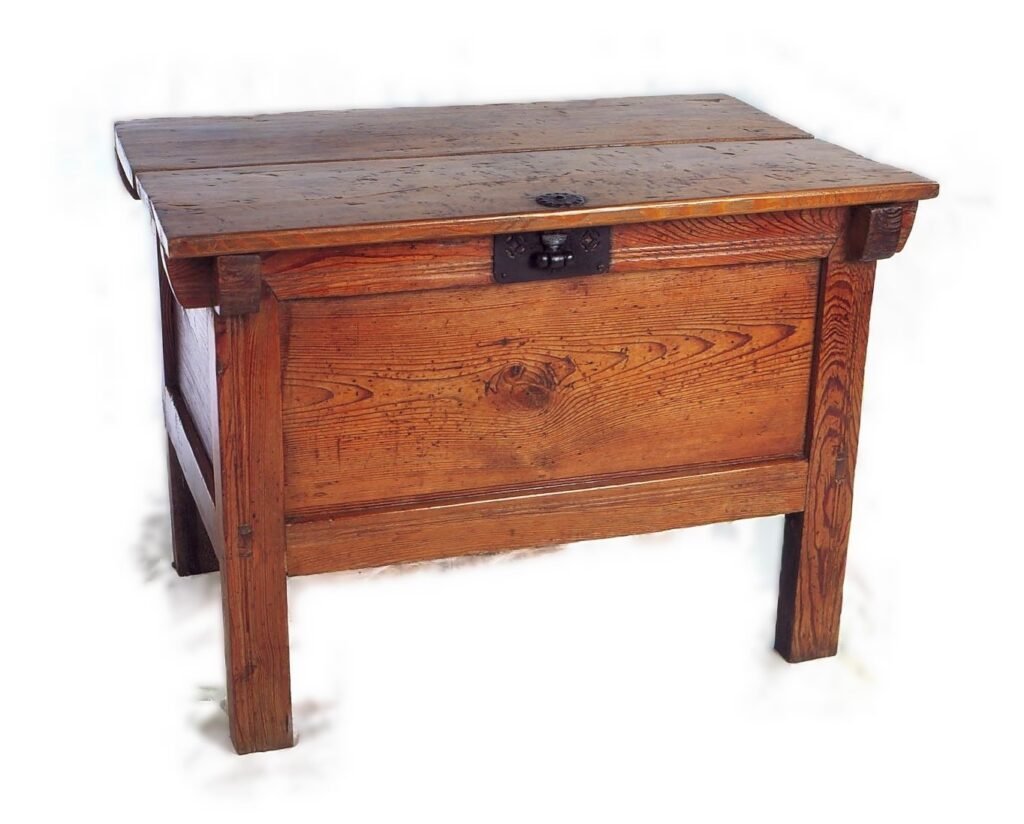
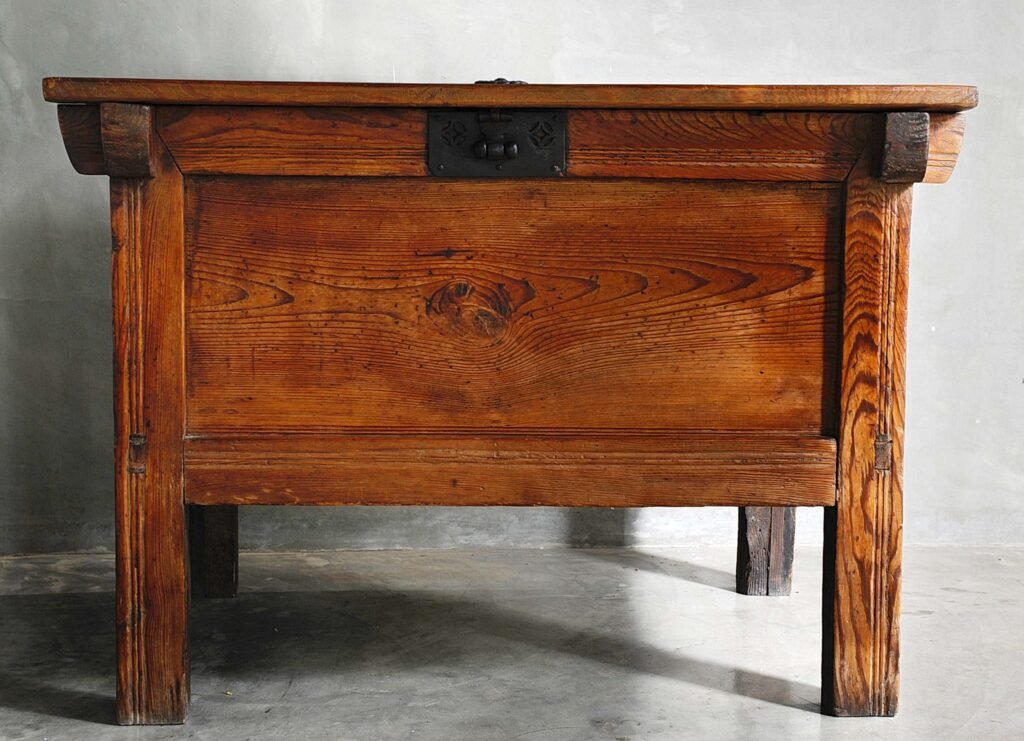
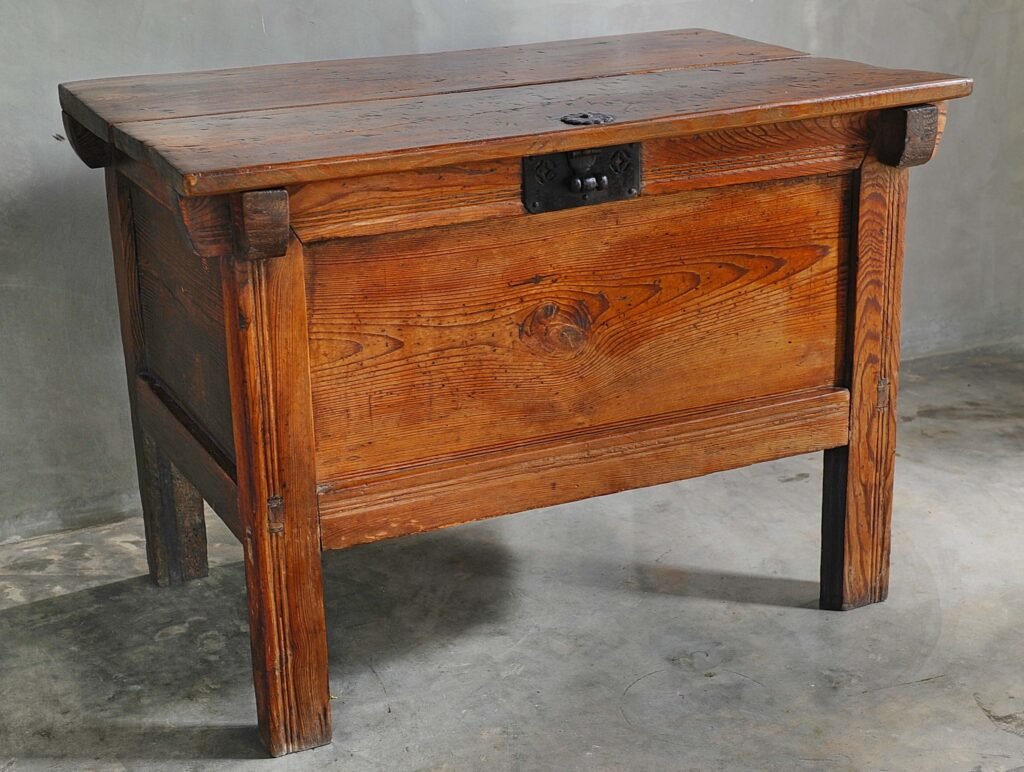
CH’ANJANG – KITCHEN CHEST – 찬장.
Pine & elm wood, iron fittings, oil finish. Three levels with a row of drawers under the top panel. Gyeonggi province. Early 20th century. H. 187cm, W. 110cm, D. 50cm.

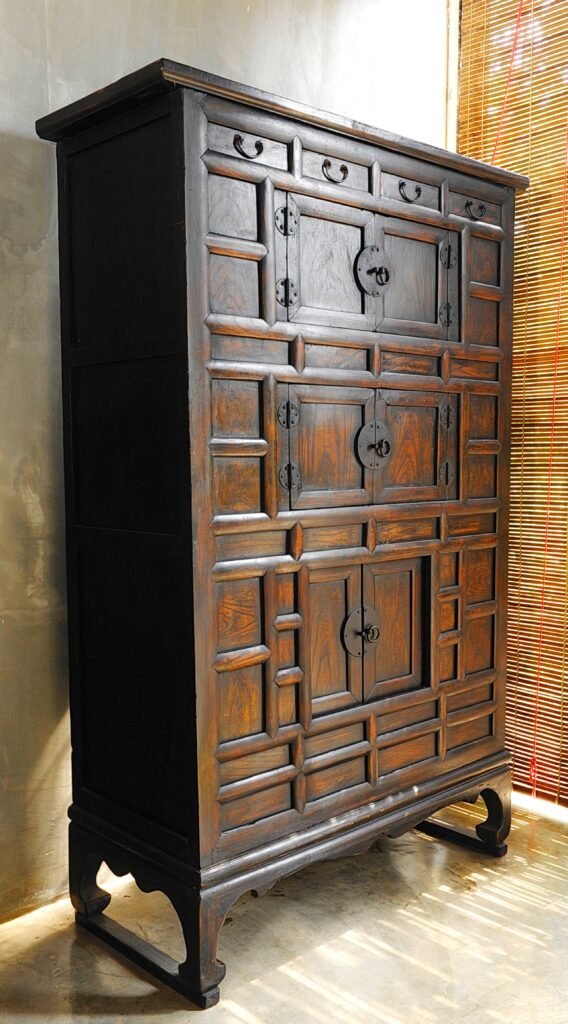
YAK JANG – MEDICINE CHEST – 약장
Elm & paulownia wood, yellow brass fittings, Gyeonggi province. Early 20th century. H. 105cm, W. 114cm, D. 40cm.
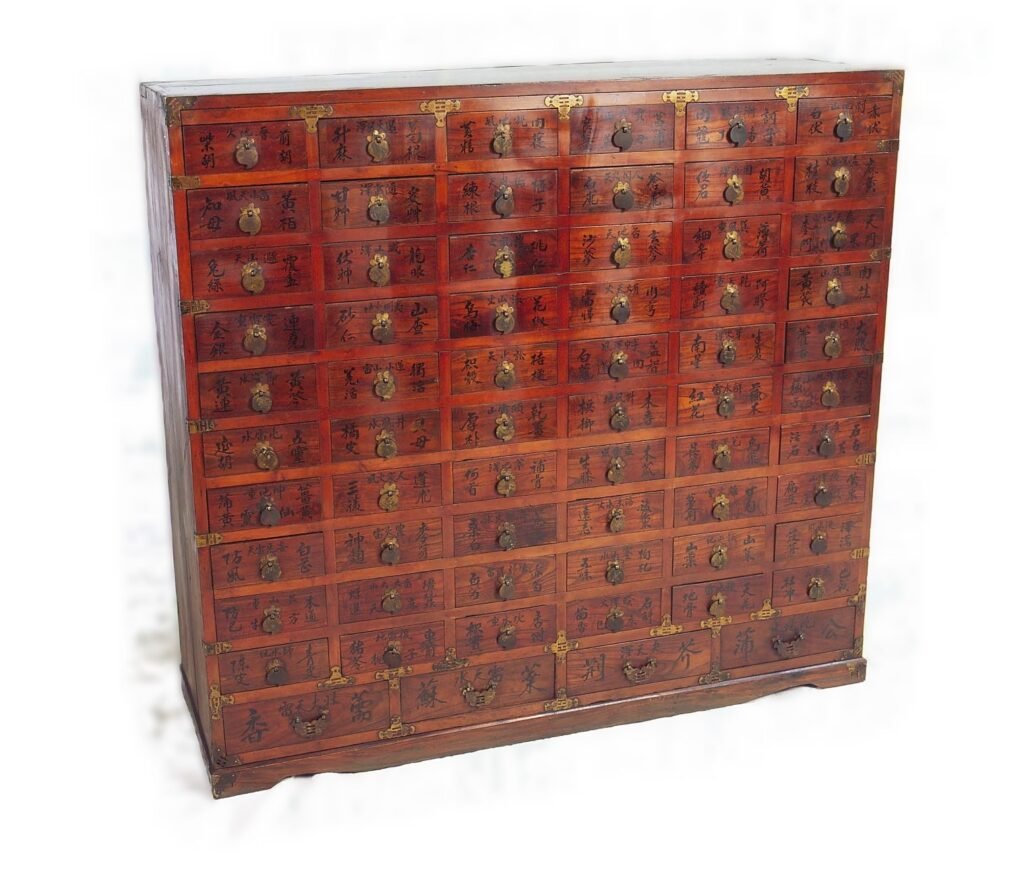
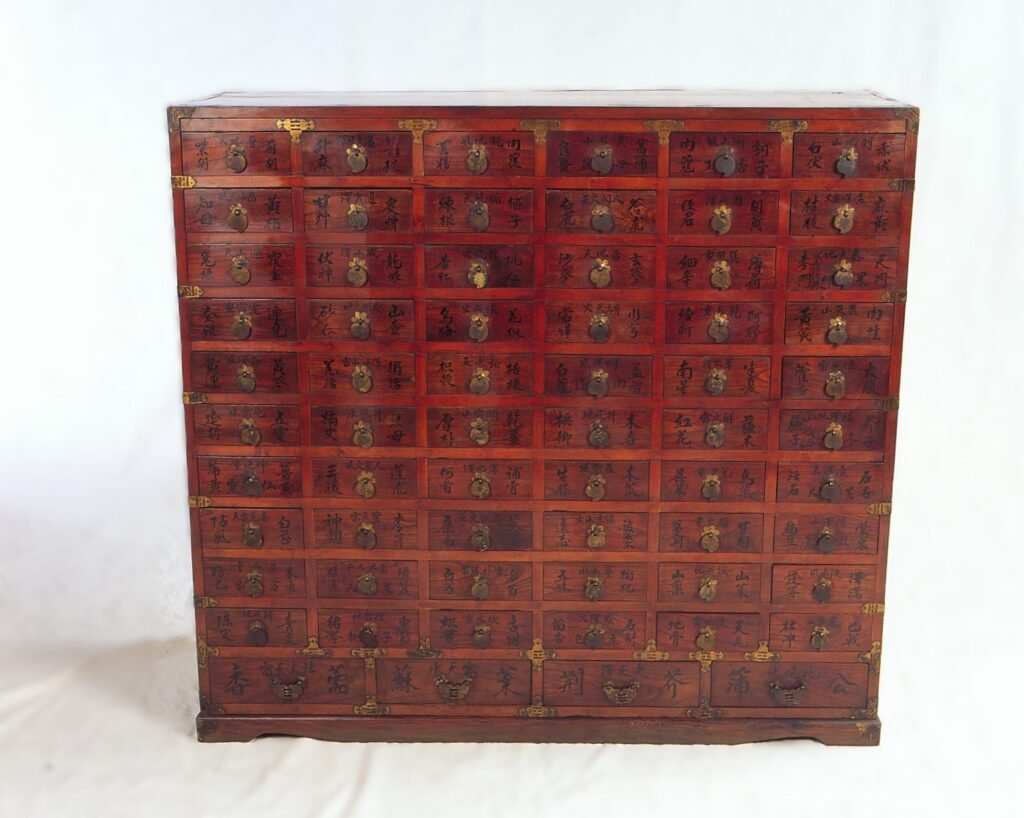
TON-KWE – COIN CHEST – 돈궤
Red pine wood, iron fittings. Half opening from the top. Gyeonggi province. Mid 19th century. H. 39cm, W. 74cm, D. 33cm.
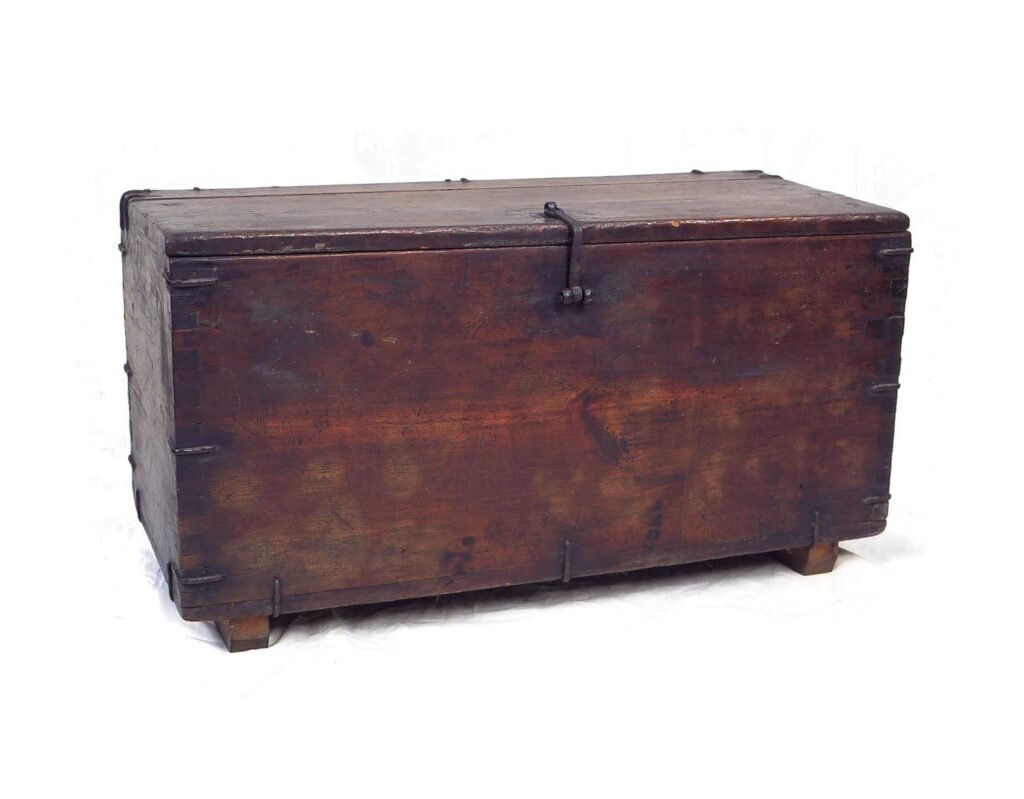
TON-KWE – COIN CHEST – 돈궤
Red pine wood, iron fittings. Half opening from the top. Gyeonggi province. Early 20th century. H. 52cm, L. 105cm, D. 65cm


YONG YEO – ANCESTOR SHRINE – 영여
Paulownia wood. Small double doors on the front and on each side. Carved flower motif in the front & a Taoist Taeguk motif on the back. Mid 19th century, Gyeonggi province. H. 58cm, W. 54cm, D. 60cm.
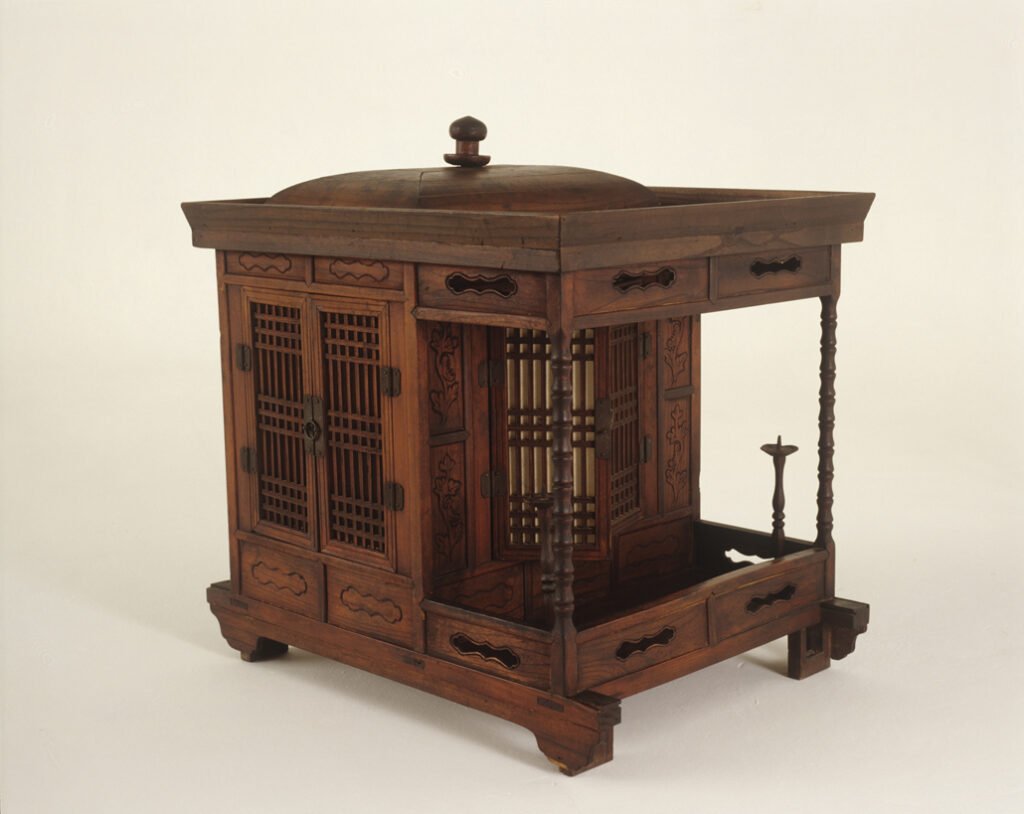
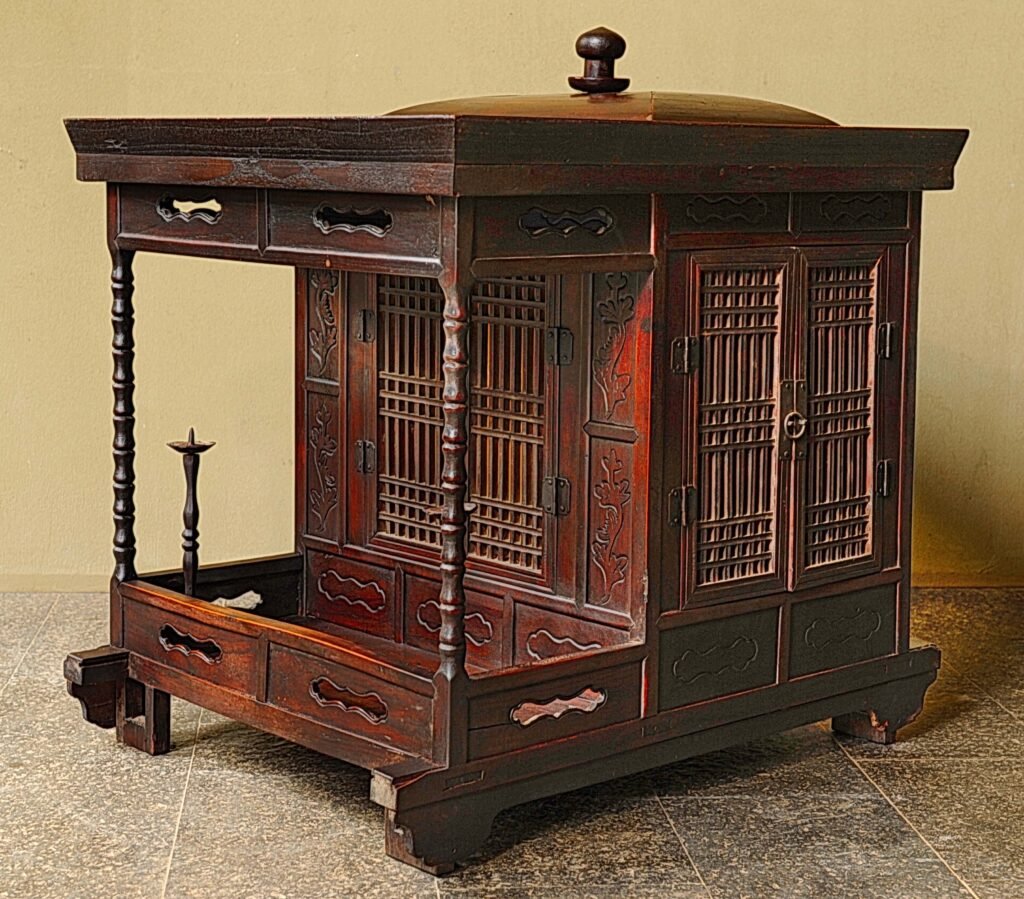
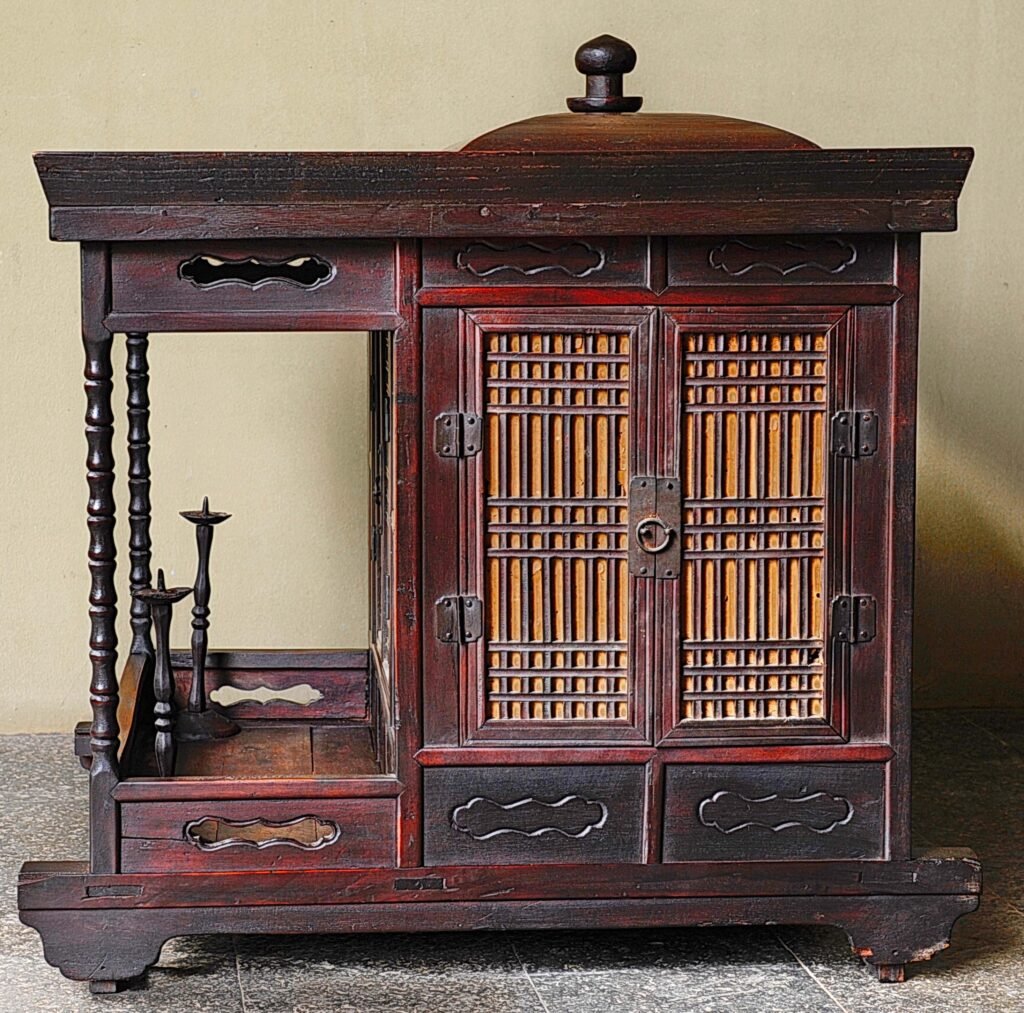
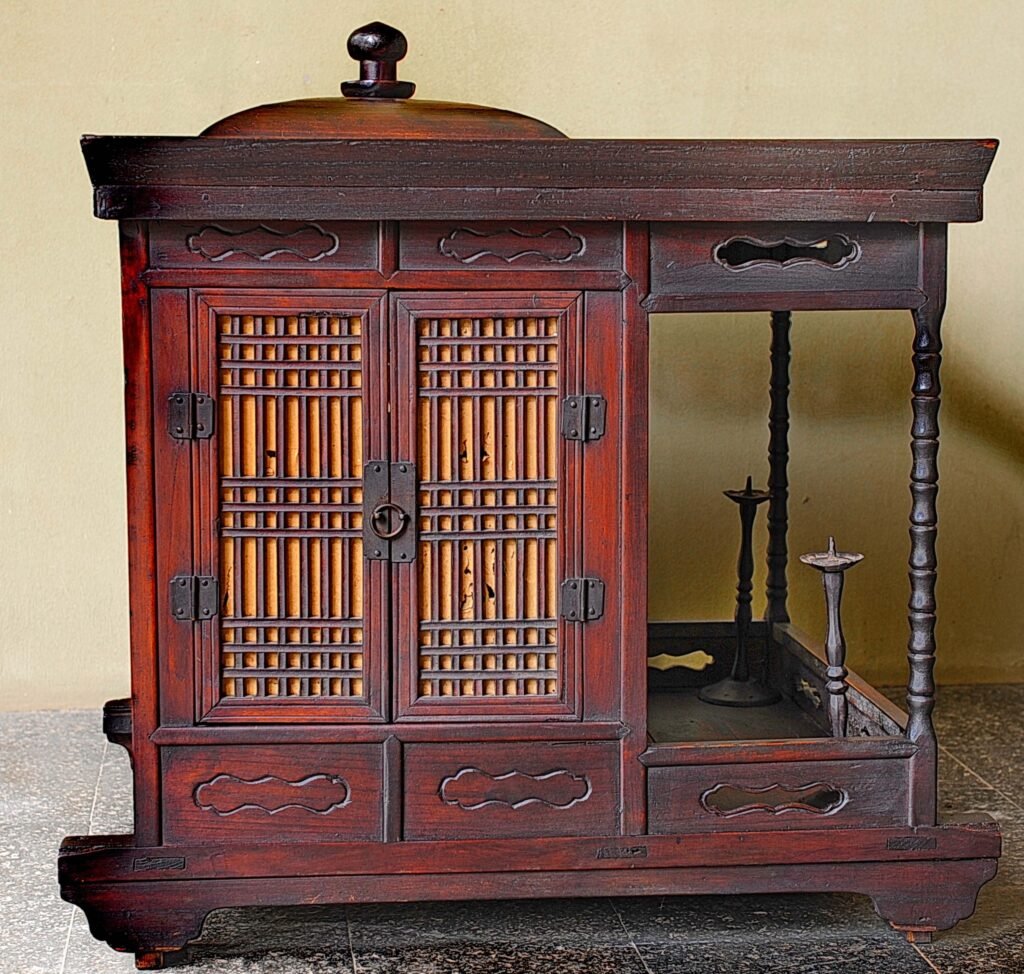
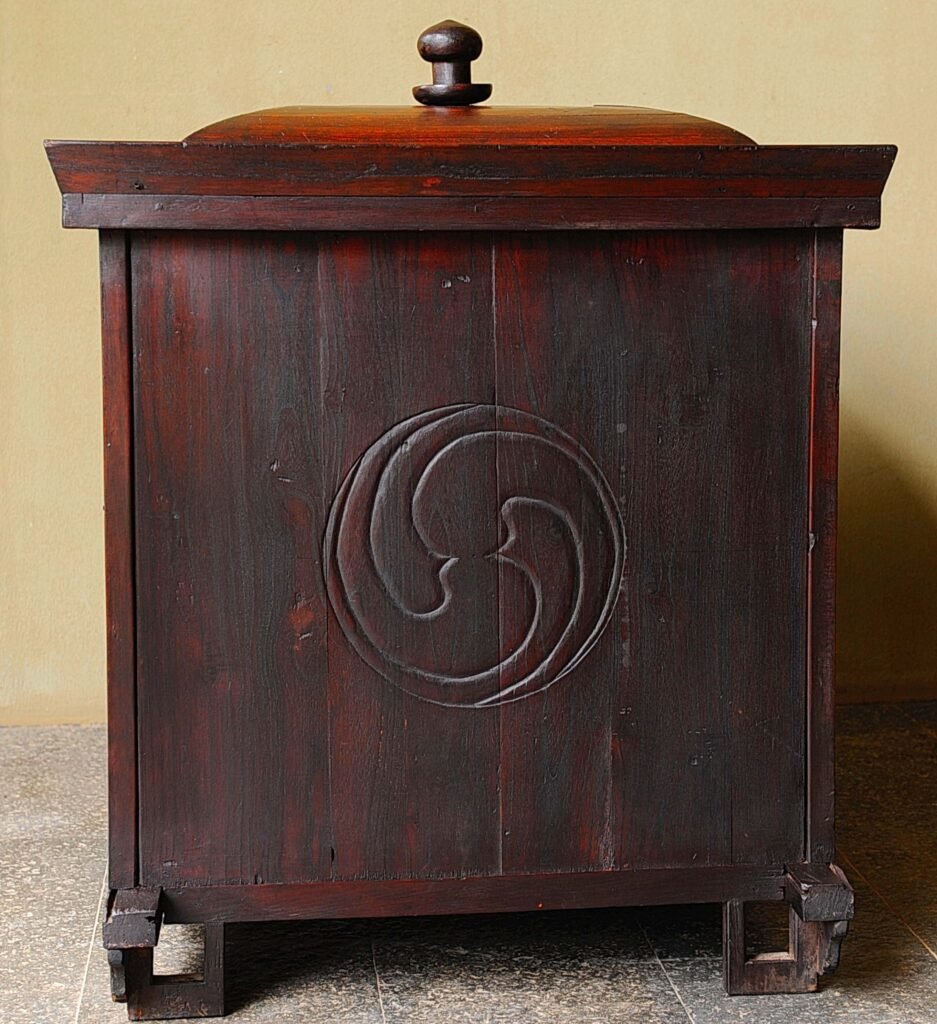
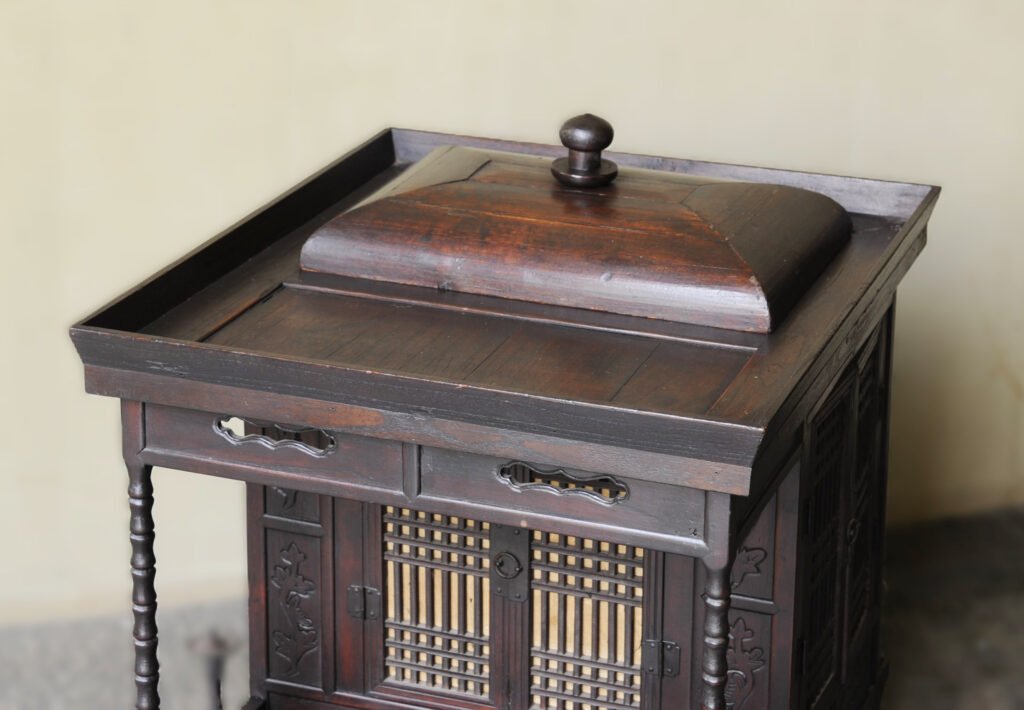
“PAN GOK” is the process of bringing back the spirit of a deceased person by carrying a small spirit bier called “YO YEO” during the funeral to the burial site and then back home along the same route.
“YO YEO“, also known as “YONG YO” or “SADANG“, is the ancestor shrine or funerary sedan chair or palanquin in which the spirit of the ancestor is preserved. Most of these shrines have now vanished.
After the “TAESANG” ceremony, which occurs 2 years after the death, the mourning shrine is dismantled, and the mortuary tablet is transferred to the family shrine known as “Gamsil“, which houses the mortuary tablets of ancestors from previous generations.
This miniature sedan shrine had long poles running through the holes in the base so it could be carried on the shoulders of men. It mimics the style and shape of palanquins used for transport of aristocratic women, but its small size indicates that it was used in funeral processions.
Today, “Yong Yo” is extremely rare and is no longer in use.
KYO YI – KOREAN ANCESTOR ALTAR- 교의
Dark stain on pine wood. Mid 19th century, Gyeonggi province. H. 46cm, W. 46cm, D. 36cm.
This item was placed on top of a furniture or altar table. Intricate back design.
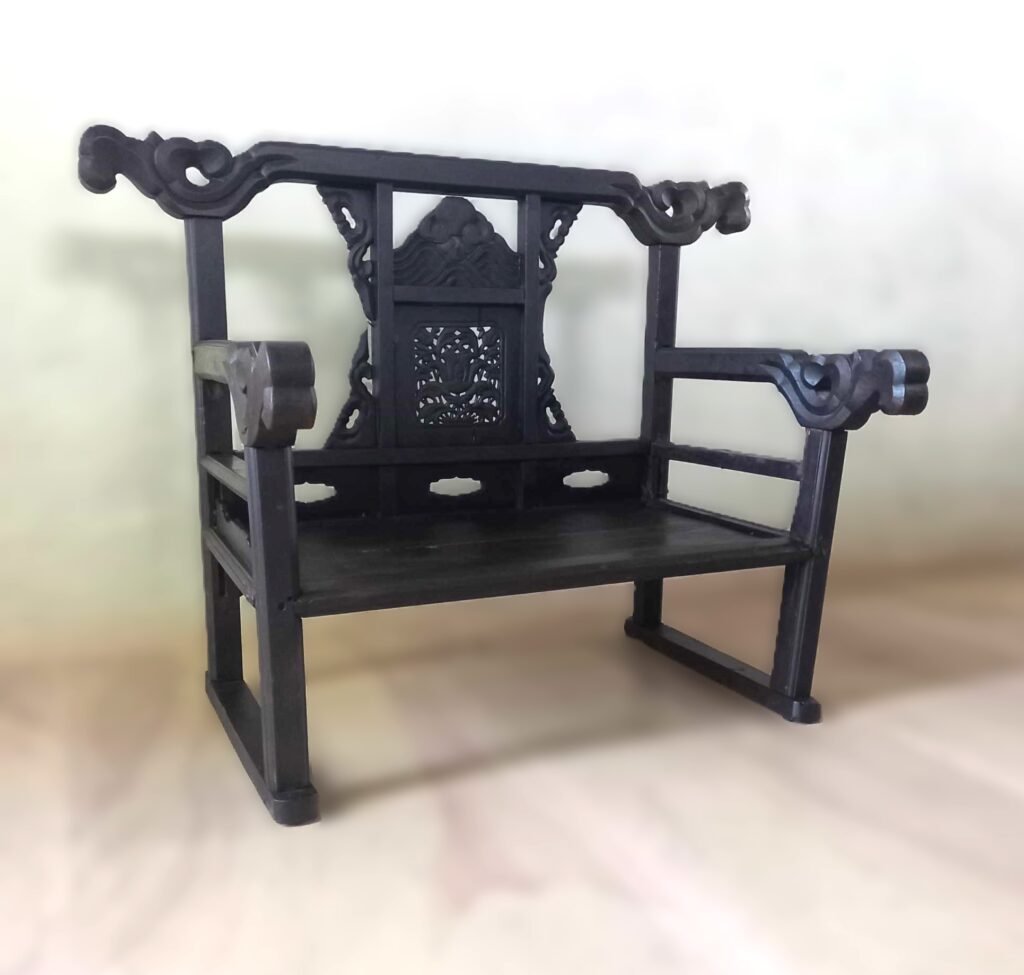



KYO YI – KOREAN ANCESTOR ALTAR- 교의
Red pine wood. Late 19th century. Gyeonggi province. H. 126cm, W. 55cm, D. 31cm.

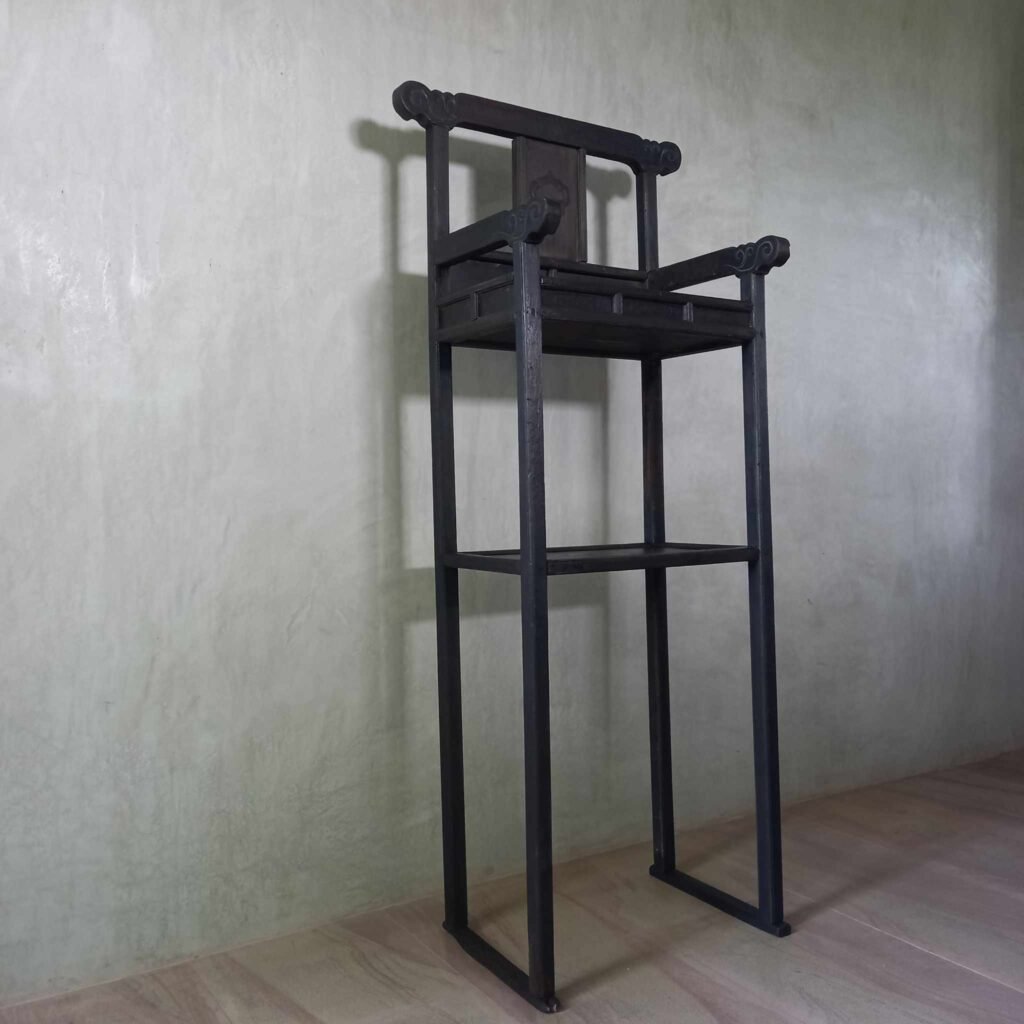
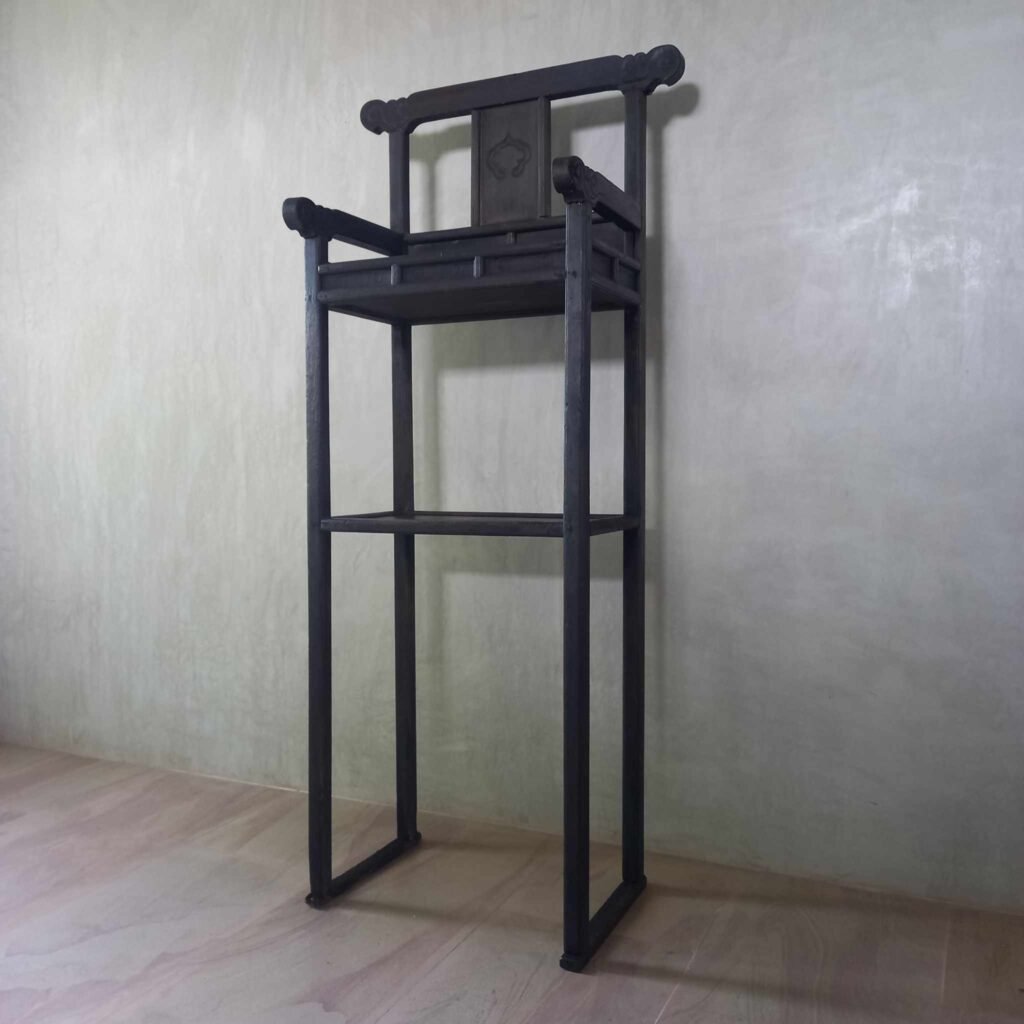

SAH IN KYO – PALANQUIN – 사인교
Pine wood, iron fittings, oil finish. Mid 19th century. H. 36cm, W. 68cm, D 92cm.
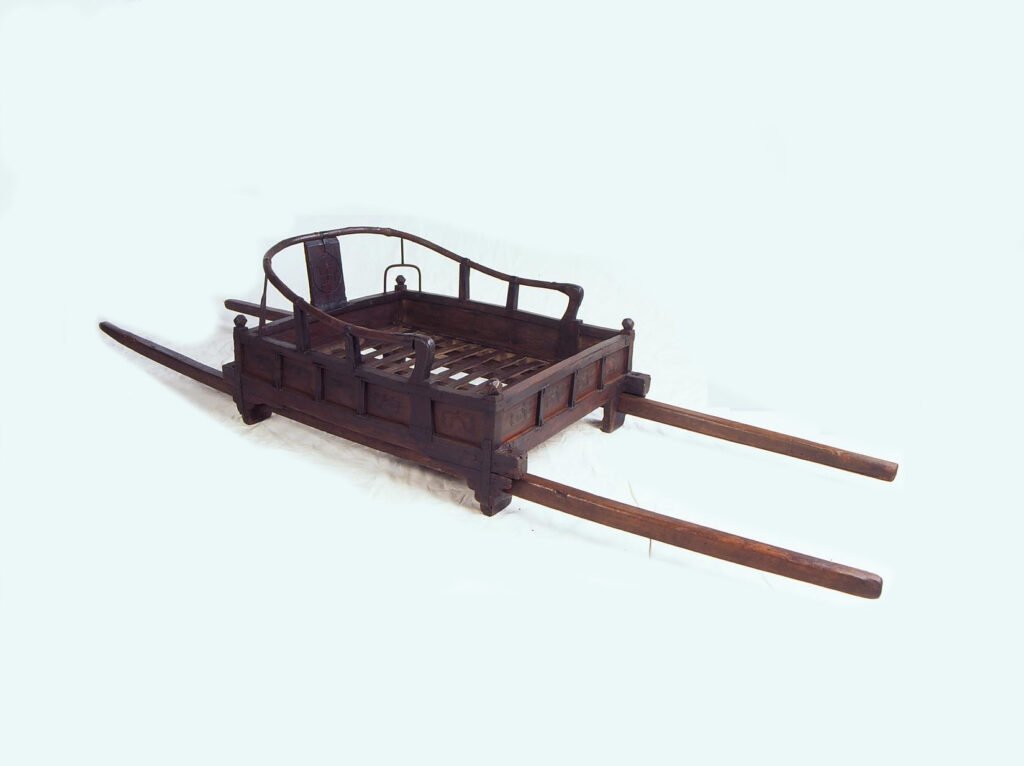

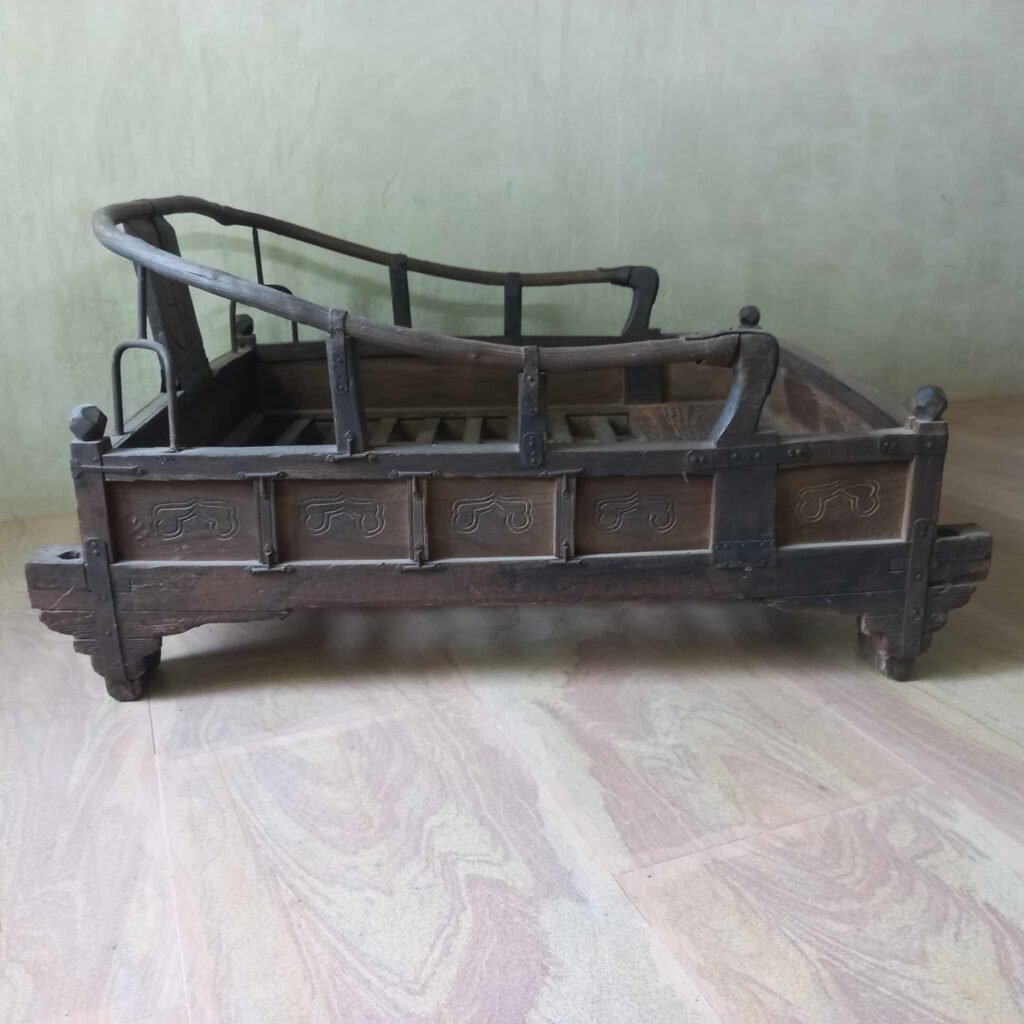
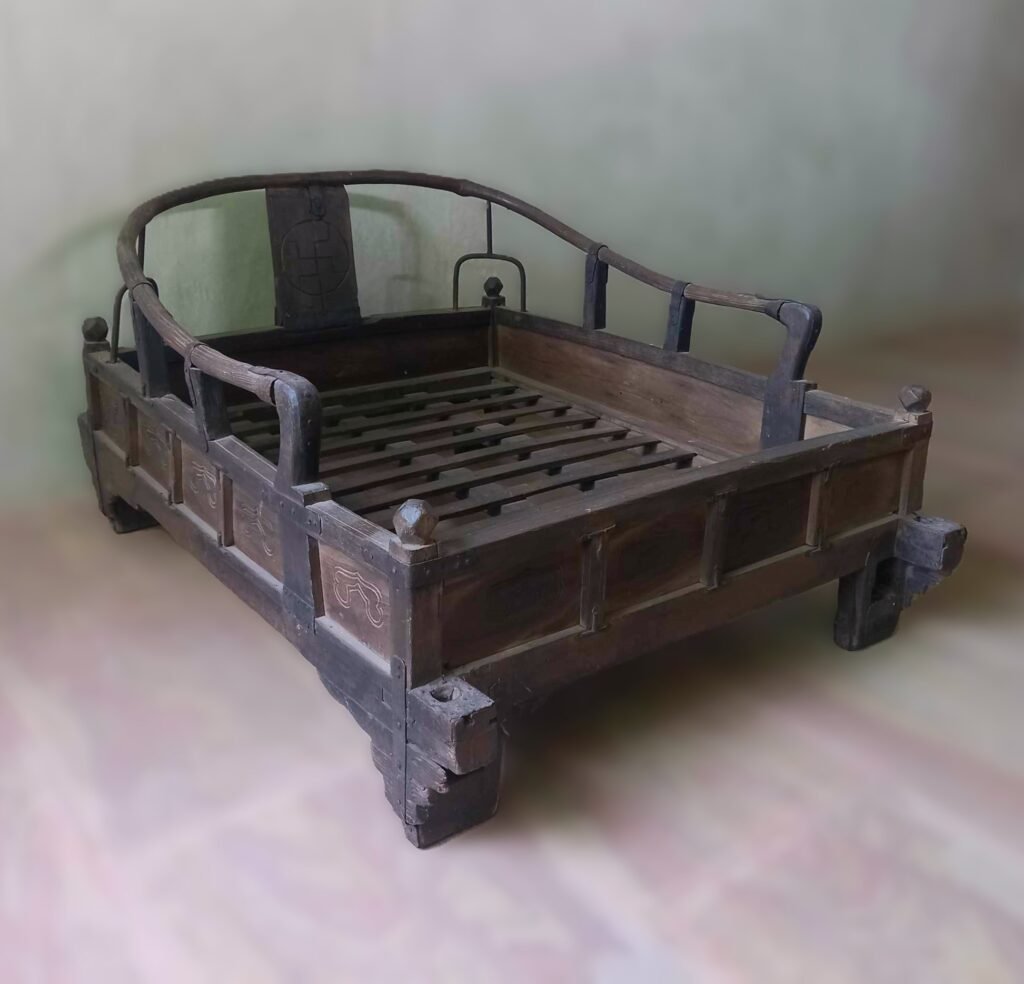
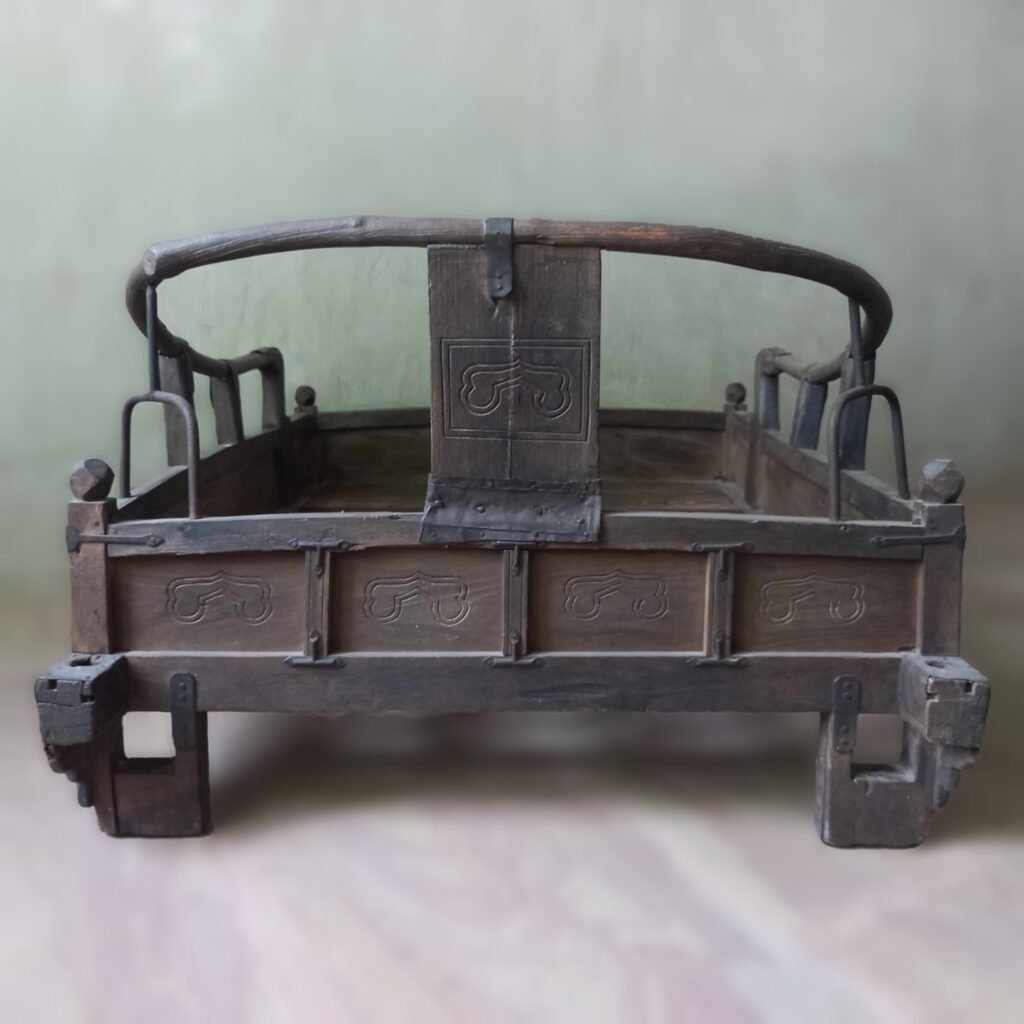
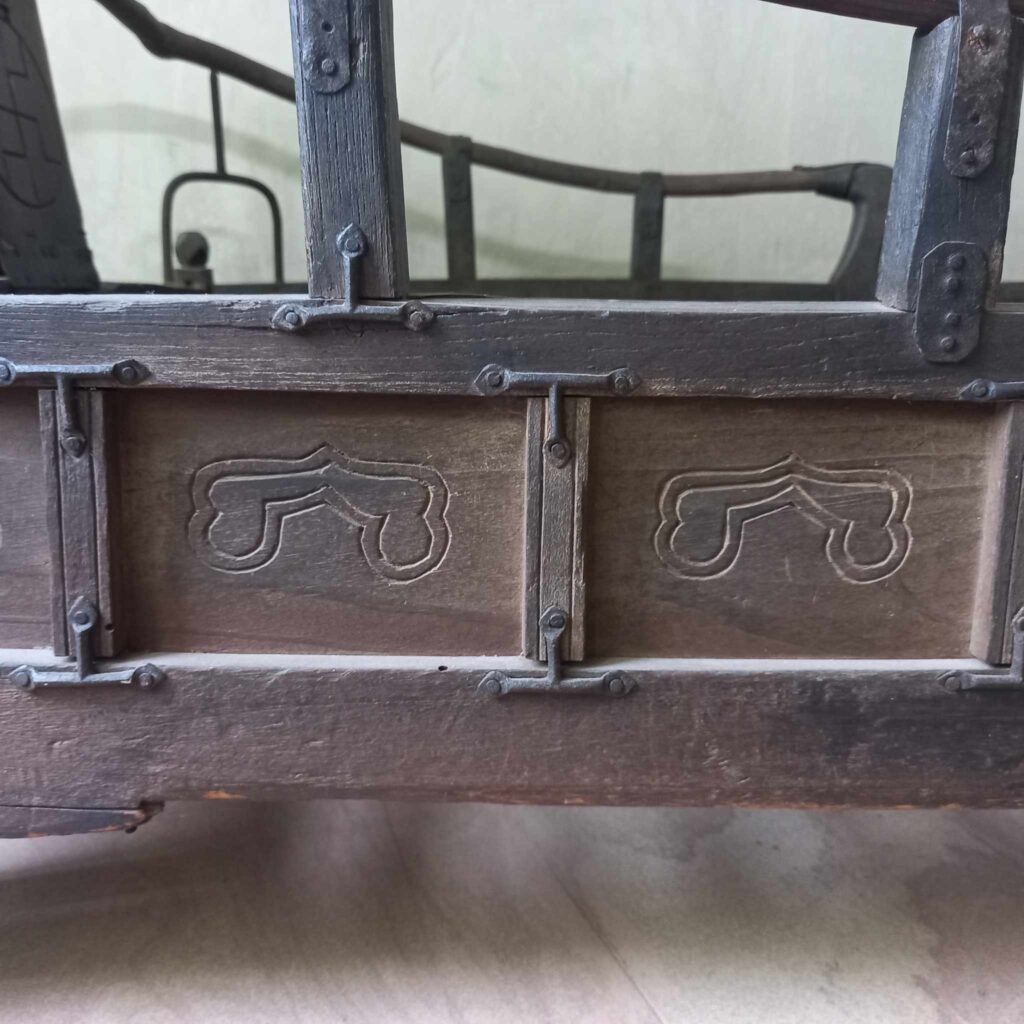
DESK – GYEONGSANG – 경상
Elm wood. Two drawers. Gyeonggi province. Late 19th century. H. 34cm, W. 92cm, D. 41cm.
This low table was used in temples for reading religious text and scrolls.
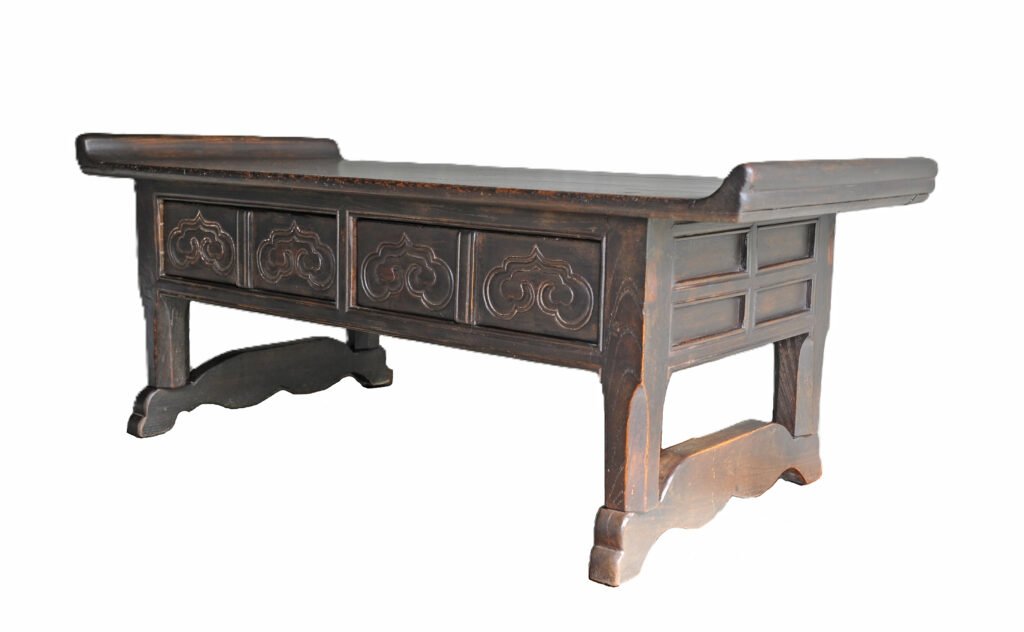
HAM – BOX – 함
Gingko and Paulownia wood (bottom), white brass fittings. Mid 19th century. Jeolla Do province. H. 15 cm, W. 22 cm, D. 22 cm.
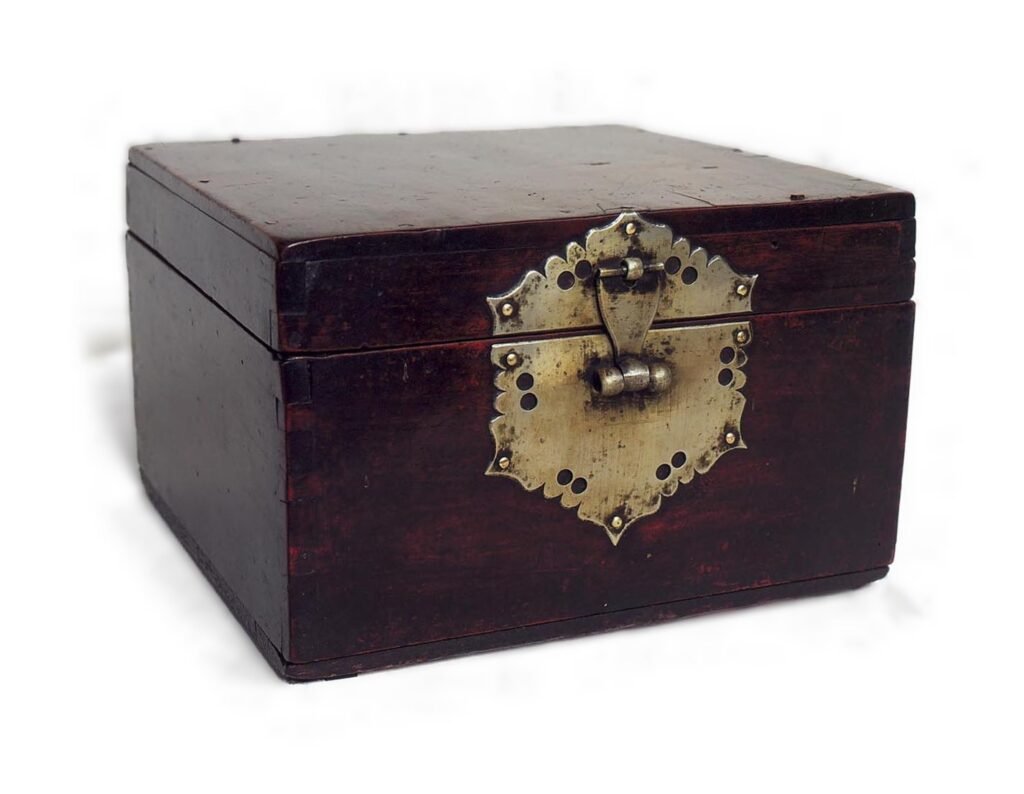
PIT CHOP – COMB BOX – 빗접
Black lacquer on pine wood,, mother of pearl inlay, yellow brass fittings. Late 19th century. Gyeongsang Province. H. 27 cm, W. 26 cm, D. 24 cm.
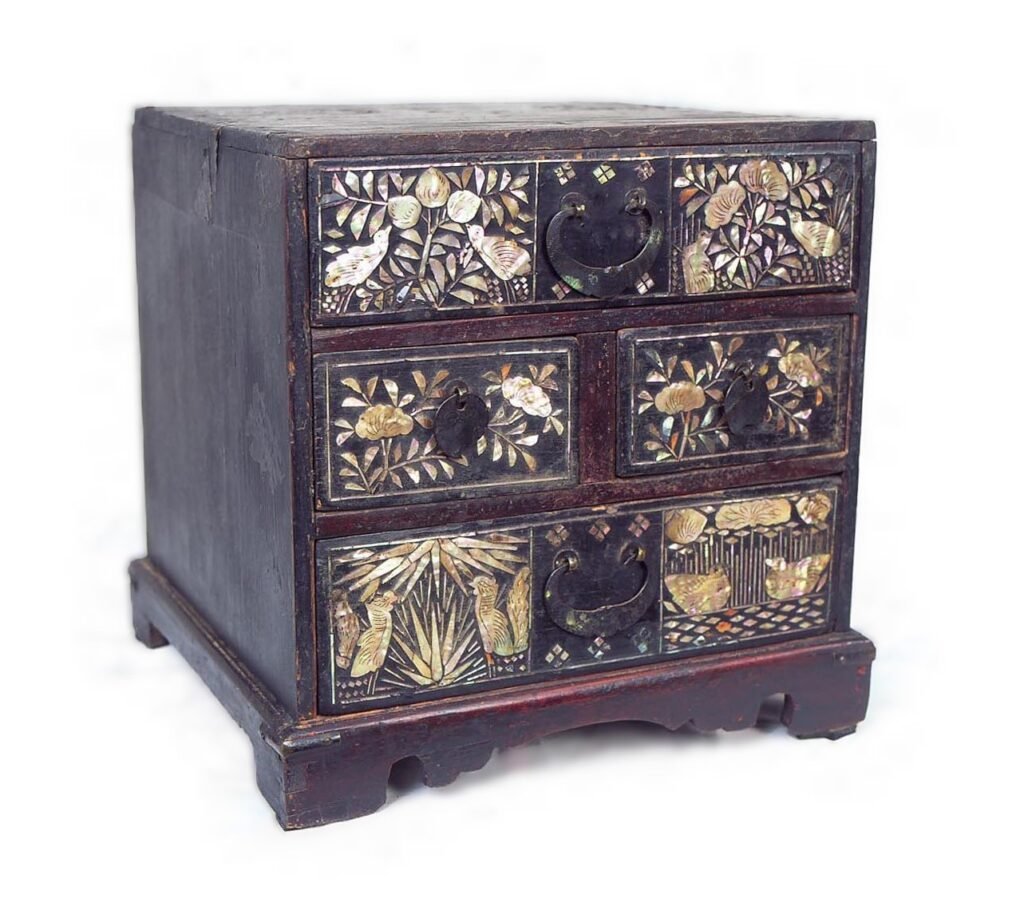
WOMEN’S INCIDENTALS BOX.
Paulownia wood, white brass fittings, oil finish. Mid 19th century.
Gyeonggi Province. H. 29 cm, W. 34 cm, D. 34 cm.

DOCUMENT BOX – SORYU HAM – 서류함
Paper covered box, clear lacquer finish, and yellow brass fittings. Late 19th Century. Gyeonggi Do province. H. 21cm, W. 47 cm, D. 24cm.
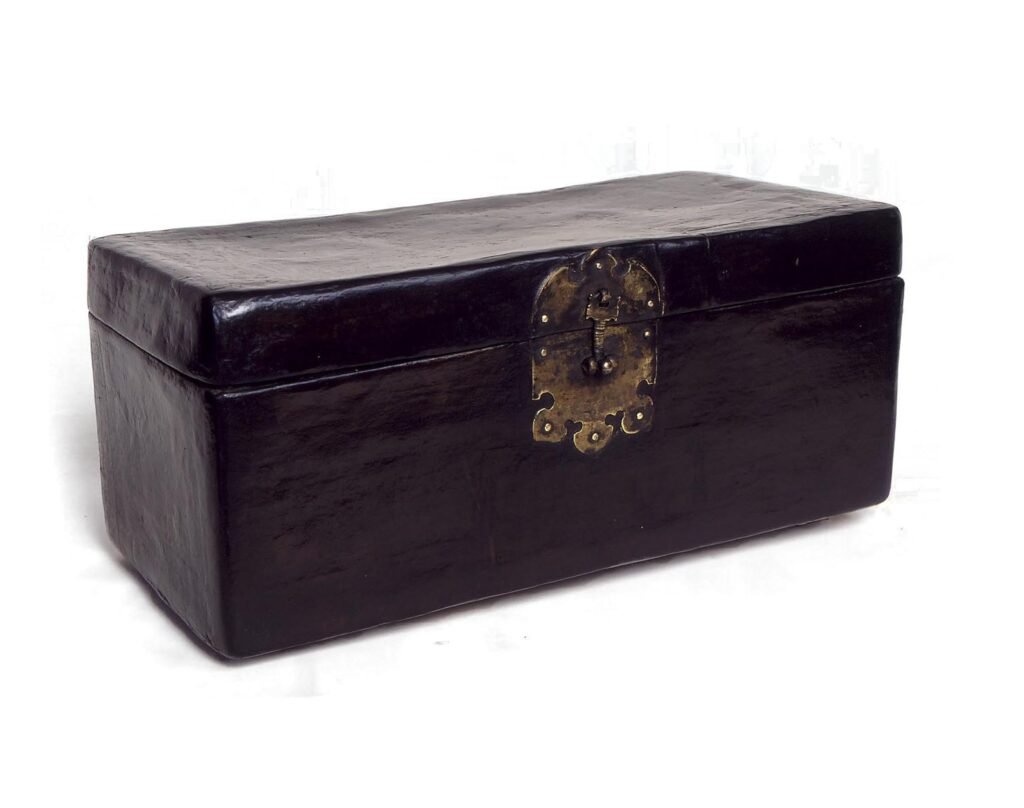
HAM – WEDDING BOX – 함
Red lacquer, Yellow brass fitting. Early 20th century. H. 30cm, W. 60cm, D. 30cm.
